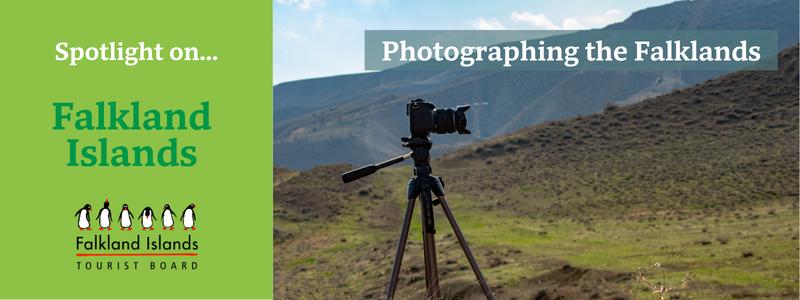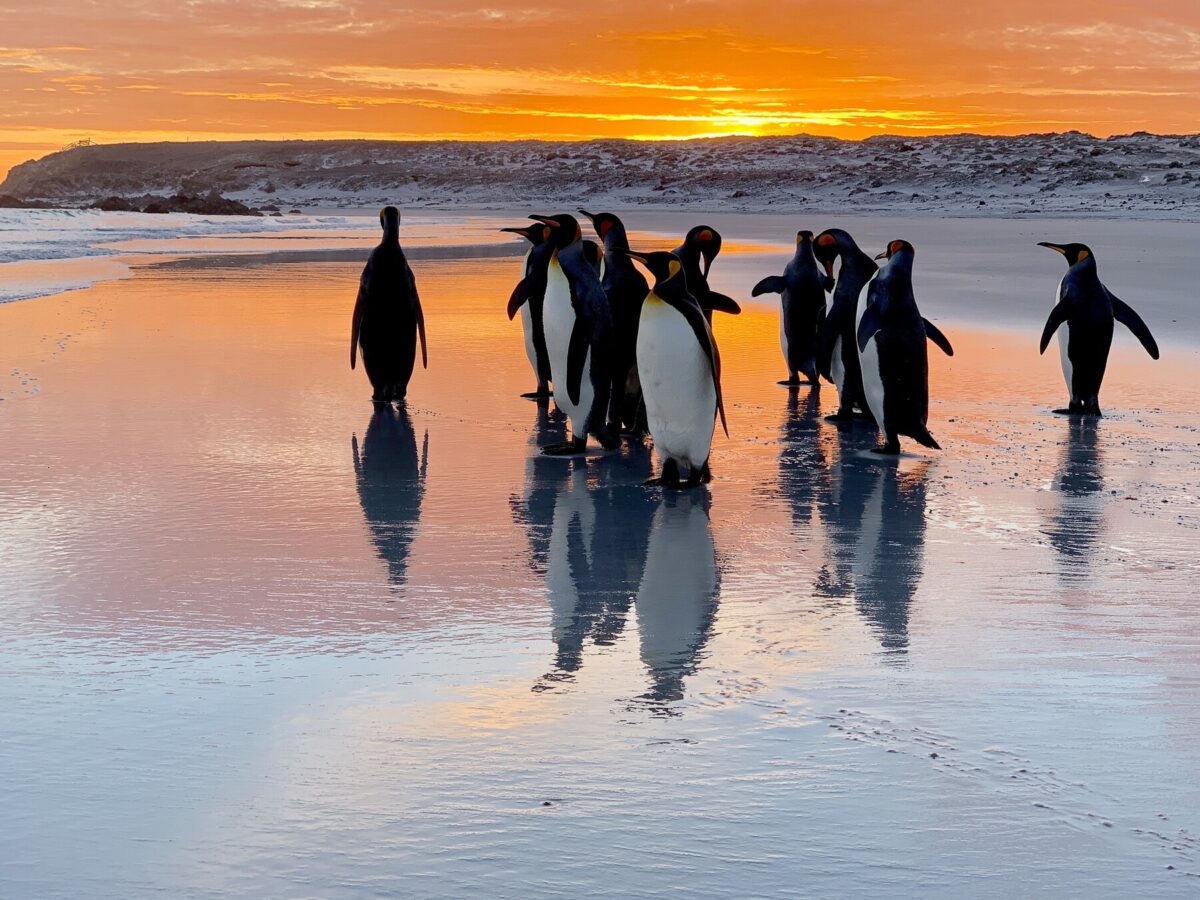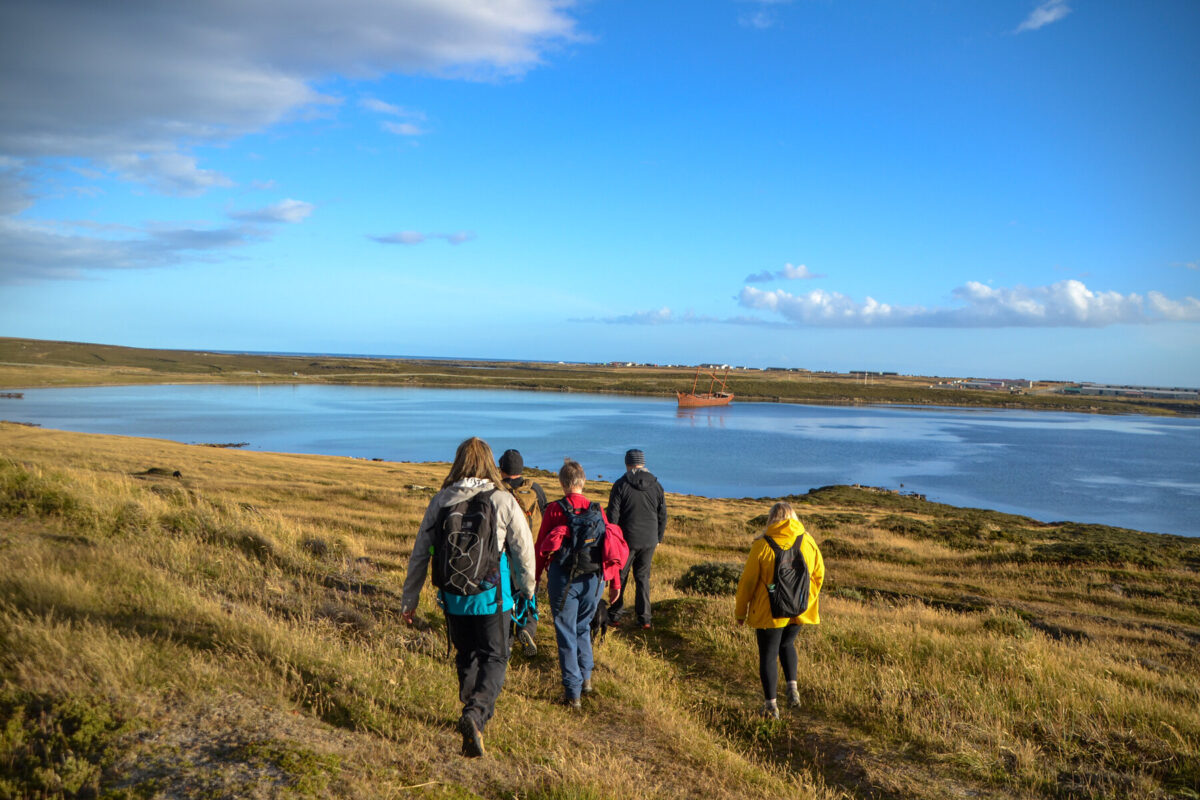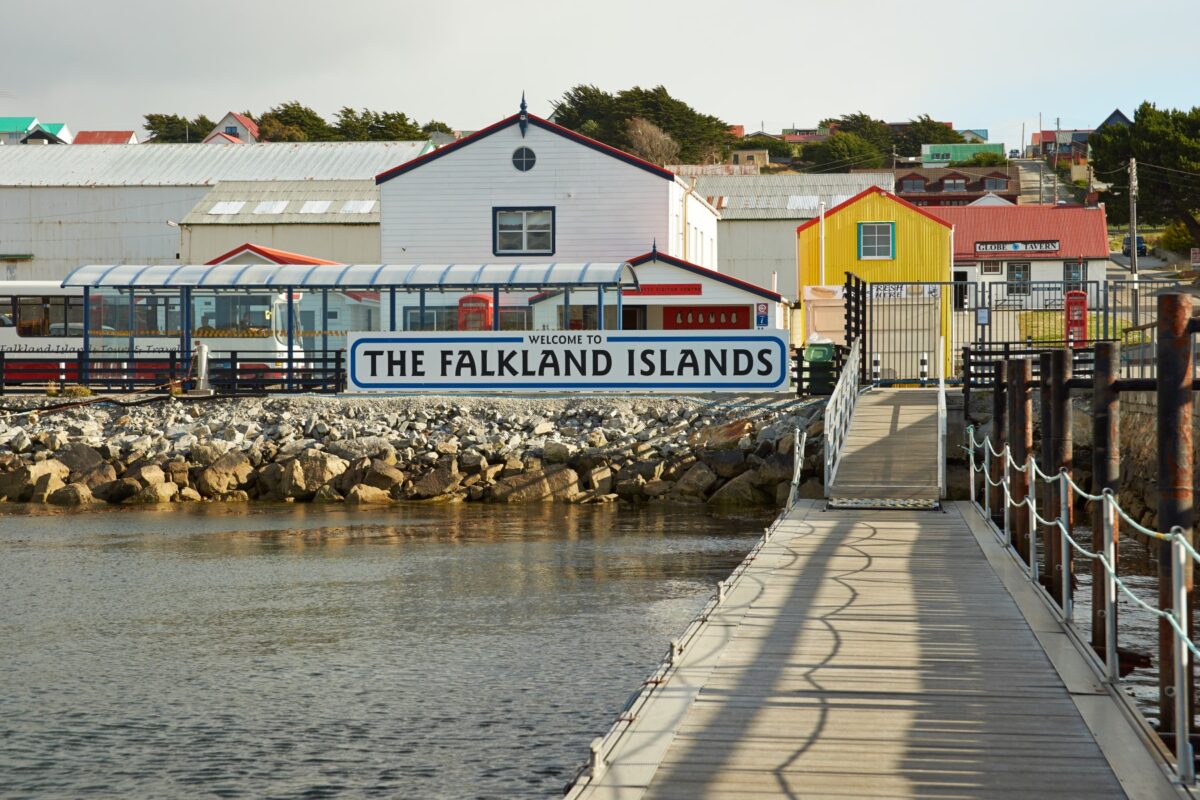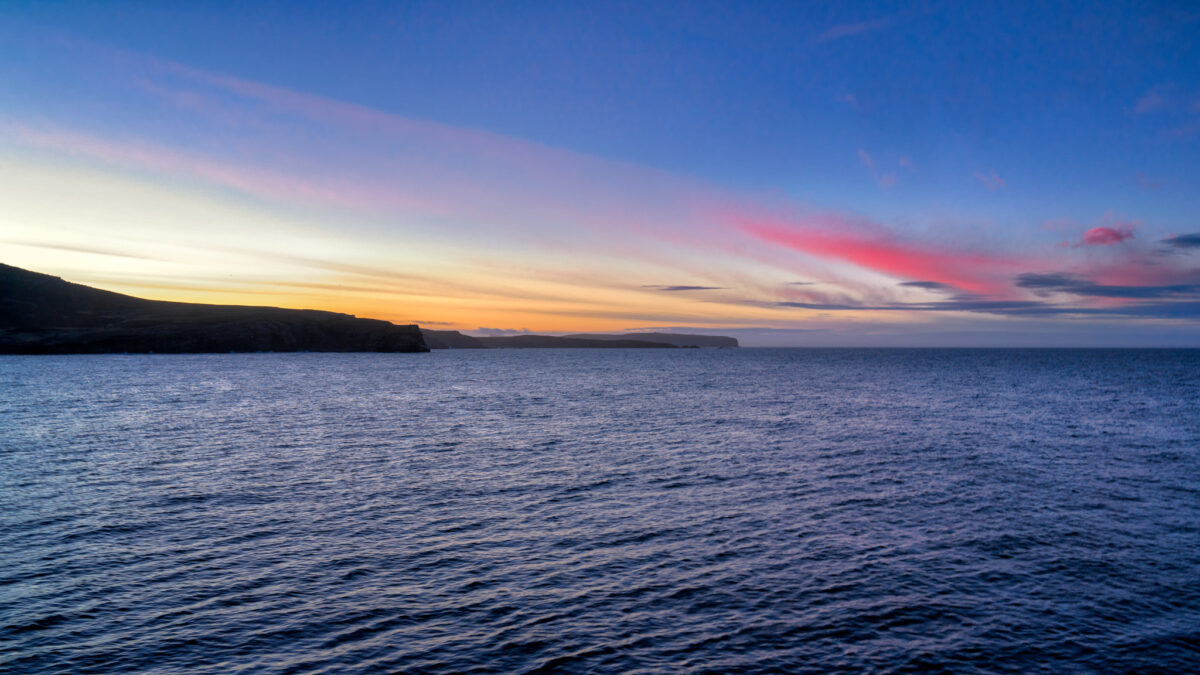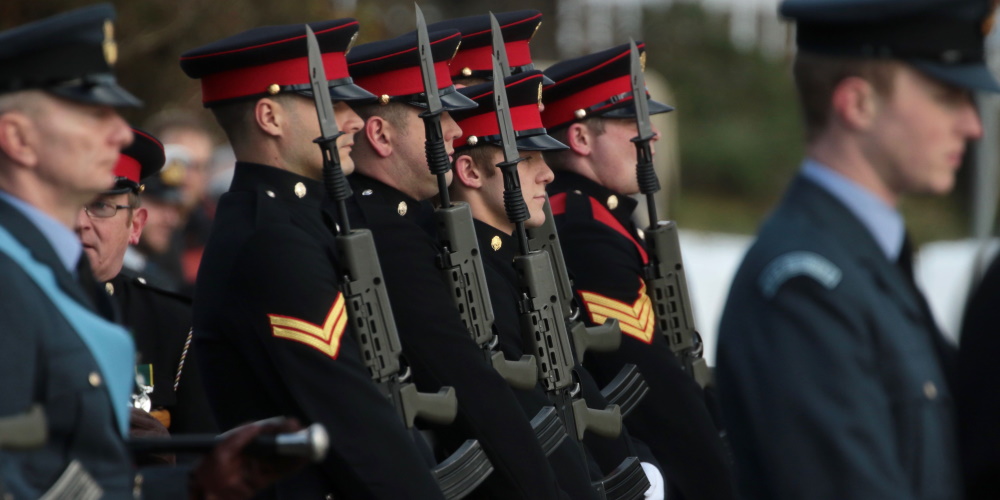Standing on the hilltops gives one a feeling of being on top of the world as the islands are laid out at one’s feet. The amazing clarity of light in these islands never ceases to amaze.
Will Wagstaff, author of Falkland Islands: the Bradt Guide
The Falkland Islands are one of our hot destinations for the year ahead – check out the full list of the best places to travel in 2024 here.
The Falkland Islands are situated between latitude 51 ̊ and 53 ̊S and longitude 57 ̊ and 62 ̊W in the South Atlantic, some 300 miles to the east of southern Argentina. There are two large islands, East and West Falkland, and over 700 smaller islands, which combine to create a total land area of 4,700 square miles (12,173km²). Most of the islands’ population of over 3,400 now live in Stanley, the islands’ capital. The remainder are spread over East and West Falkland and 12 of the smaller islands.
Stanley has grown considerably in recent decades with new houses now east and west of the original town and more being built every day. However, the relaxed pace of life is still the same, even if the smell of peat smoke does not linger over the town as it did in the past.
The islands hit the international headlines when Argentina invaded in April 1982, and the subsequent recapture by the British Forces raised the islands’ profile in the world at large. A fledgling tourist industry took advantage of this post-war interest to offer holidays to these wild and beautiful places. The numbers of cruise ships visiting is still increasing, enabling more visitors to reach this isolated archipelago. Income generated by the advent of the fishing industry and tourism has increased the standard of living thus encouraging more to make the islands their home.
Stanley and New Island are at opposing extremes, east and west, 148 miles (238km) apart. The coastline is highly indented with many rocky headlands and sandy beaches. Large inland bodies of water are absent but there are many small lakes and pools. Mount Usborne at 2,312ft (705m) in the Wickham Heights range on East Falkland is the highest point on the islands. Standing on the hilltops gives one a feeling of being on top of the world as the islands are laid out at one’s feet. The amazing clarity of light in these islands never ceases to amaze.
The prospect of seeing elephant seals, killer whales and penguins attracts many visitors to the islands. The Falklands, although not as rich in species of flora and fauna as nearby South America, offer an abundance of spectacular wildlife to gratify our continuing fascination with nature. Sitting quietly not far from a penguin colony and seeing them come out to see you is a magical and memorable experience.
The Falkland Islands are one of those magical places in the world that capture the imagination, and although the weather is not always clement, the overriding memory is of blue sea, blue sky, teeming wildlife and smoko as soon as you get back indoors.
For more information, check out our guide to the Falkland Islands:
The Falkland Islands are on our list of 2023 Exceptional Trips! Read the full list here.
Food and drink in the Falkland Islands
Food
The food on the islands is very British in character with much use made of the homegrown vegetables, local lamb, mutton, beef and fish. Portions are habitually on the generous side with smoko – homemade cakes and biscuits with tea or coffee – being enjoyed in the gaps between meals. Diddle-dee jam and teaberry jam can sometimes be found, the latter being more seasonal and the former often sold in the shops in Stanley. Homemade soup with fresh homemade bread is a common meal at lunchtime and is often welcome after a morning spent wildlife watching.
For those looking for something a little different upland goose pâté is available as a starter in some restaurants with toothfish (Patagonian sea bass) also a popular choice for a main course. Other fish options can include locally caught trout and mullet. Outside of Stanley there is nowhere to eat out other than the lodges and the larger guesthouses, and then only by prior arrangement. The range of places to go out for a meal in Stanley is changing all the time, from à la carte through to fish and chips and bar lunches.
Drink
All lodges across the islands are licensed and stock a good range of beers, wines and spirits. The same can be said for the hotels in Stanley. There are also six pubs in Stanley, which are open between 10.00 and 23.00 on Monday to Thursday, between 10.00 and 23.30 on Friday and Saturday and between 12.00 and 14.00, and again between 18.00 and 22.30, on Sundays.
Most alcohol is imported into the islands and, despite the transport costs, drinks are not as expensive as might be expected owing to the differing tax levy between the islands and the UK, the main source of the imported drink. Draught beer is now brewed on the islands by Falkland Beerworks again after a short-lived brewery in the late 1980s. This Stanley-based brewery opened in 2012 and has been producing four beers: ‘Rock Hopper’, a natural blonde at 4.2% ABV; ‘Longdon Pride’, a best bitter at 4.2% ABV; ‘Peat Cutter’, an oatmeal stout that is a little stronger at 5.5% ABV; and ‘Black Tarn’, a dark mild at 3.4% ABV. More recently, they have added ‘Iron Lady’, an IPA (India pale ale) at 5% ABV to their list. Some of these are available on draught in the Victory Bar and at the Malvina House Hotel in Stanley, with bottled beers available at the Waterfront Hotel. Stocks can run low after visits from the larger cruise ships to Stanley.
Health and safety in the Falkland Islands
Health
No inoculations are required when planning a visit to the islands. However, those passengers travelling on the RAF flights are recommended by the Ministry of Defence to be inoculated against yellow fever in case the flight has to be diverted to a yellow-fever-risk area. As the yellow-fever vaccine is a live vaccine it may not be suitable for everyone. Please seek advice from a travel-health professional working in a registered yellow-fever centre.
Visitors travelling to the islands via South America should consult their doctor as to which inoculations they may require. It also makes good sense to be up to date with a tetanus jab (ten yearly). The hospital in Stanley has qualified doctors, dentists and other medical staff to cope with any contingencies. The islands’ water supply is safe to drink.
Safety
The Falkland Islands must be one of the safest places for the single traveller to visit. Crime is relatively unknown; muggings and pickpockets belong to another world. The friendly islanders will often go out of their way to assist visitors, and if an emergency does arise phoning 999 will alert the emergency services. The one question often asked about the islands concerns minefields and any other military activity. Apart from a few vehicles in Stanley, occasional planes and helicopters, the military presence is more-or-less confined to the area around Mount Pleasant. Life on the islands carries on pretty much as it always has done.
The image of the Falkland Islands and minefields is unfortunately engraved on public consciousness outside the islands. The total mined area is minuscule, only affecting patches around Stanley and smaller fields at Goose Green, Fitzroy, Fox Bay and Port Howard. Recent minefield clearances have greatly reduced the number and size of the minefields around the islands. All minefields are clearly marked and fenced off. Islanders quite rightly point out that no civilian has yet been injured by mines or any unexploded device since the minefields were laid by Argentinian troops in 1982.
Driving on the islands is a unique experience whether it is over the camp or along the modern road network. There have been accidents along the road between Mount Pleasant Airport and Stanley, mostly due to excessive speed on a loose surface. Driving along this road, with its deep roadside ditches, in windy conditions demands a great deal of concentration. The well-concealed boggy areas have trapped many a vehicle passing over the camp, and local knowledge can save a lot of hard digging. If driving away from the made-up roads, a 4×4 is essential as the ground can be very soft in places, even in the summer months.
Travel and visas in the Falkland Islands
Visas
The Falkland Islands are relatively free of red tape apart from the usual entry formalities. All travellers arriving on the islands should have a valid passport, a visa if required and return air tickets or evidence of prepaid onwards travel arrangements. The visa requirements are broadly the same as those for the UK.
Visitors must also have sufficient funds to cover their stay on the islands and have pre-booked accommodation. Before the baggage is collected every passenger is gathered in the baggage-retrieval lounge to listen to a briefing on the current minefield situation. This includes displaying some of the mines that were used during the 1982 war and the general whereabouts of the minefields.
A Falkland Islands Departure Tax will be levied on the islands for those visitors who have not paid this in advance through their tour operator. One further restriction that visitors should be aware of is that, as all the land on the Falkland Islands is privately owned, permission should be granted from the owner before crossing land for whatever reason.
Getting there and away
By air
There are two air routes to the Falkland Islands: from RAF Brize Norton in Oxfordshire, England or via commercial airlines to Santiago, Chile, then connecting with the LATAM Chile flights via Punta Arenas to Mount Pleasant Airport. The LATAM Chile flights operate every Saturday. Travelling from England, the Royal Air Force flights are now operated for the Ministry of Defence (MOD) by a company called Air Tanker.
These flights leave the UK twice weekly, but are sometimes subjected to delays if adverse weather conditions are prevailing on the islands; a comprehensive travel insurance package is advised. Typically, this means leaving the UK on Sunday and Wednesday evenings and returning on the corresponding Tuesdays and Fridays. This schedule may change during bank holiday periods.
If planning to travel independently on the RAF flight you must deal directly with the travel co-ordinator at the Falkland Islands Government office, where full information and a travel form can be obtained.
An alternative is to travel via Chile. Tourists can board the LATAM Chile flight in Santiago, via Punta Arenas to the Falkland Islands. There is also a monthly flight via Argentina which calls at Rio Gallegos on the second Saturday of the month on its way to the islands, returning one week later.
From Rio Gallegos, it is possible to fly to Buenos Aires and other destinations in Argentina as well as Punta Arenas in Chile. Connecting with the LATAM Chile service is a Falkland Islands Government Air Service (FIGAS) flight from Mount Pleasant to Port Howard on West Falkland, and on to Pebble Island. This flight is designed to give short-stay visitors the maximum time with wildlife, and must be pre-booked with FIGAS or with one of the local tour operators.
By sea
An increasing number of visitors are reaching the islands on board cruise ships that call in on their way to South Georgia and to the Antarctic. The sheer size of the larger ships restricts their visits to Stanley. Ships typically anchor out in Port William and then use their tenders to come through Stanley Narrows to land at the public jetty in front of the visitor centre. These visits range from a few hours to a full day depending upon their itineraries.
The smaller ships, usually termed Expedition cruise ships, can land at a variety of sites. They most often stay around the islands for one day on an outer island followed by another day or half day in Stanley. The weather plays a major role in how successful these landings are with some cancelled because of strong winds.
It is also possible to sail to the islands on a private yacht, but it is essential to contact the Customs and Immigration Department and the Harbour Authorities at least 24 hours before arrival as well as seeking clearance by customs and immigration in Stanley before continuing elsewhere in the islands. For those arriving from South America the islands are typically more than one day’s sail from ports such as Ushuaia in Argentina.
Getting around
By air
Travelling around the islands is much easier than it was prior to the early 1980s. The quickest way to get between the islands and settlements is by air on the Falkland Islands Government Air Service (FIGAS). These planes operate from their base at Stanley Airport and can take up to eight passengers plus pilot, although many airstrips are only capable of accepting planes with a reduced number of passengers.
By sea
The Concordia Bay ferry between New Haven on East Falkland and Port Howard on West Falkland has opened up travel opportunities between these two islands. For those hiring vehicles in Stanley, this is an alternative to flying between the two main islands, but note that it is advisable to check that the car-hire company allows its vehicles to be taken to West Falkland before hiring.
The journey takes 1 hour 45 minutes and the schedule is regularly updated as the ferry also delivers cargo to all inhabited islands.
By land
The road network has been improved so that as of 2013 it now links all of the major settlements on the islands; all others can be reached by traditional routes over the camp on the rough, rather difficult-to-drive tracks that can only be driven using a 4×4. Local knowledge is essential in finding the correct route.
Although the distances between settlements are not great, driving over camp is slow going with average speeds of five to ten miles an hour typical so it is a good idea to allow plenty of time if doing such a journey.
When to visit the Falkland Islands
To see the islands at their best it is advisable to plan a visit during the austral summer, October to April, when the tourist industry is geared up to ensure that visitors truly appreciate the archipelago, its wildlife and its way of life. The long summer evenings of December and January offer a welcome respite from winter in the northern hemisphere. It is possible to visit the islands at any time of year; however, some of the accommodation closes out of season.
The reproductive cycles of the local wildlife may dictate when a visit to the Falklands is scheduled. Penguins are a major attraction and they, in common with many other breeding seabirds, are at their most vocal when displaying in the early months of the summer. Chicks abound in midsummer. Southern elephant seals and southern sea lions can be seen throughout the tourist season, as can the scarce fur seal. The greatest concentrations of these impressive beasts are to be found during the pupping seasons in spring and midsummer. Killer whales, although far from common, are best observed when the pups start leaving the beaches.
As is to be expected, the flora is much more impressive in springtime when the majority of plants are in bloom; however, there are always some late spring and summer flowers, and several species produce attractive berries in the early autumn.
It is possible to come to the islands to fish for sea trout from 1 September to 30 April, although September and October and mid-February to mid-April are thought to be the optimal times for this species. Falkland mullet are not so seasonably variable and can be caught throughout the fishing season.
Climate
The paramount climatic feature of the Falkland Islands is wind. The islands are usually described as having an oceanic climate dominated by the prevailing westerlies. Footage of the events of April, May and June 1982, showing the military in action in snow and ice, have resulted in a public perception that the islands are snow-covered throughout the year, as though comparable with the Antarctic. In fact, the islands have a rather narrow temperature range from 19°C in January to 2°C in July, with an average annual mean temperature of 6°C.
Very warm days are rare during a Falkland summer, although the islands enjoy more sunshine hours than the south of Britain. The general lack of pollution and dust in the atmosphere increases the penetration of ultraviolet rays, so a high-factor suncream is an essential part of the visitor’s travel pack. The sea temperature varies very little during the year on average with a range of between 6°C and 7°C.
Public holidays and events
Liberation Day on 14 June commemorates the liberation of the islands after the invasion by Argentina in 1982 and is marked by a service in Christ Church Cathedral followed by a parade to a wreath-laying ceremony at the Liberation Monument a short distance along Ross Road. There is usually a large military representation for this. Battle Day on 8 December is to commemorate the battle between the British Navy and the German South Atlantic Squadron, which resulted in the loss of most of the German squadron. There is a parade to the 1914 memorial on the headland to the west of Government House followed by a service and a fly-by from the RAF.
Peat Cutting Day was reinstated as a public holiday on the first Monday in October in 2002 to mark the traditional start of the peat-cutting season. There is relatively little peat cut these days as most islanders use oil or electricity for heating, but the day off work in some hopefully spring-like weather is enjoyed all the same.
The major sporting event in the Falkland Islands’ calendar is the Stanley Races over 26 and 27 December. This takes place at the race course at the eastern end of Stanley and involves a variety of horse races of up to a mile in length. There are also junior races as well as many others over this popular two-day event. Another sports event, the West Falkland Sports, takes place around the end of the shearing season, the location moving to a different settlement on West Falkland each year.
What to see and do in the Falkland Islands
Bleaker Island
Lying to the southeast of Lafonia, Bleaker Island was on the tourist map for many years only as a stopping point for some of the cruise ships visiting the islands. However, the opening of high-class self-catering accommodation nearly 20 years ago opened up the island to all visitors, from both land and sea.
This long, thin island is over 12 miles (19km) long, but is only one mile (1.6km) wide at the widest point. It is still stocked with sheep but has a very good range of wildlife, including three species of breeding penguin, and as such has been designated an Important Bird Area (IBA) by Birdlife International. The northern part of the island is a National Nature Reserve. Although it is not as famous as some of the other wildlife sites around the archipelago, Bleaker Island has plenty to offer and is well worth including in any itinerary. The modern accommodation is centrally placed and is ideal for exploring as it is only a short walk away from a huge king shag colony, with the rockhopper penguins also nearby. Here, visitors get a real sense of being away from it all.
What to see and do on Bleaker Island
The highlight of this island is the rockhopper penguin colony of some 720 pairs that is situated only a short walk from the settlement although for many the colony is rather overshadowed by the 9,000 pairs of king shags situated on the flat ground in the centre of the island, not far from the settlement. The sheer number of birds flying in and out of the colony along with the attendant gulls and skuas rather dominates the skies. You have to pass these king shags in order to reach the rockhoppers, and it is worth spending a bit of time watching this bustling community.
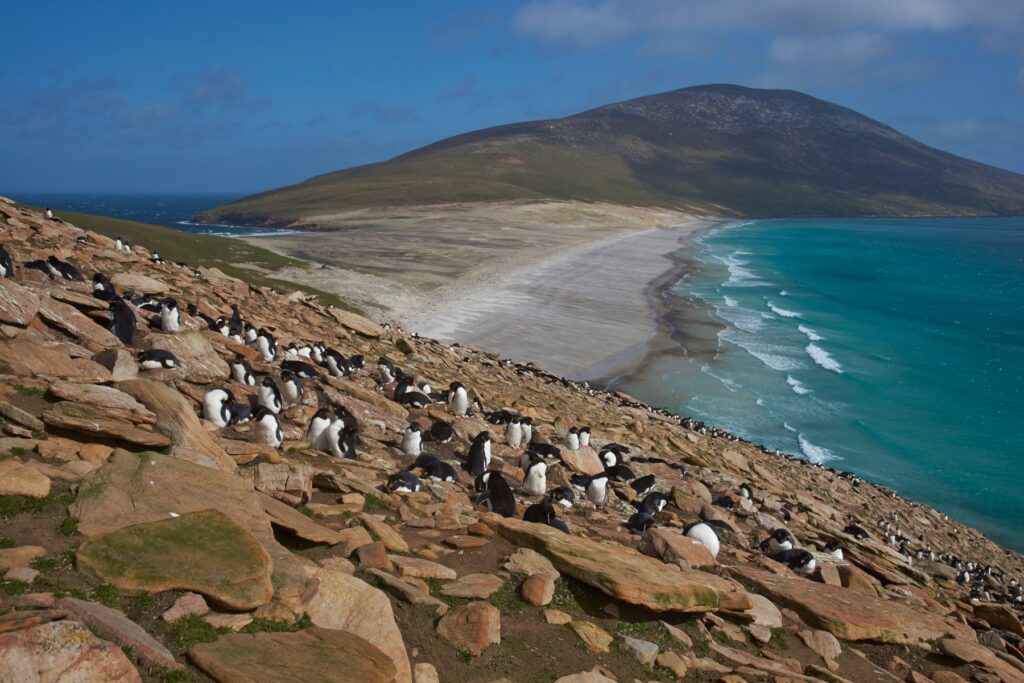
The rockhopper colony is situated on the low cliffs on the eastern side of the island just over half a mile from the settlement at Long Gulch. Further south, a colony of gentoo penguins can be found, along with a scattering of magellanic penguins. Rock shags also breed on the outer cliffs.
The pools on the island contain both white-tufted and silver grebe, as well as many wildfowl, including the occasional black-necked swan. Big Pond, a 20-minute stroll north of the settlement, is an excellent spot for wildfowl including silver teal and white-tufted grebes and can hold the odd ornithological surprise such as white- tufted coot from South America. In rough weather many of the gulls that would normally be feeding out over the kelp beds will come and roost beside the pool. There are patches of tussac grass in various locations about the island, which are home to a population of grass wren. There are also some small tussac islands offshore; First Island, Second Island and Third Island are in the bay by the settlement, and Sandy Bay Island and North Point Island are home to some of the birds that can occasionally be seen on Bleaker Island, including Cobb’s wren and tussacbird.
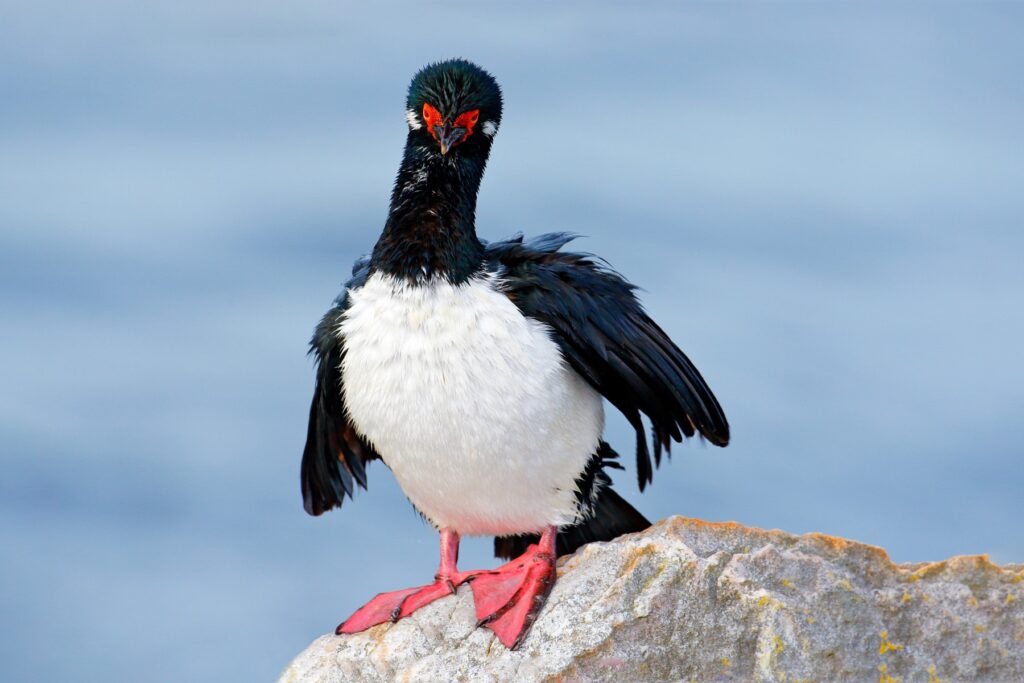
Birds of prey are well represented on Bleaker Island, with breeding southern caracara and the occasional striated caracara, which have probably come from Sea Lion Island to the southwest. Southern sea lions can often be seen hauled out on the rocks but do not breed on the island. Up to 40 have been seen at any one time, although this number does vary from time to time.
The islands’ meandering coastline means that there are miles of open country for walking and long sandy beaches for those that like to potter along the strand line. You can walk straight down the middle of the island from one end to the other, but then you would miss out on the various pools, sheltered bays and the wildlife that uses these locations. It’s a rather low-lying island, with a high point of only 27m at Semaphore Hill, but to get to each bay you will walk over slightly elevated ground thus the views are varied. As it is also a narrow island you can zig-zag up and down, looking for flora such as lady’s slipper as well as yellow orchid and dog orchid. These are at their best in late November and early December.
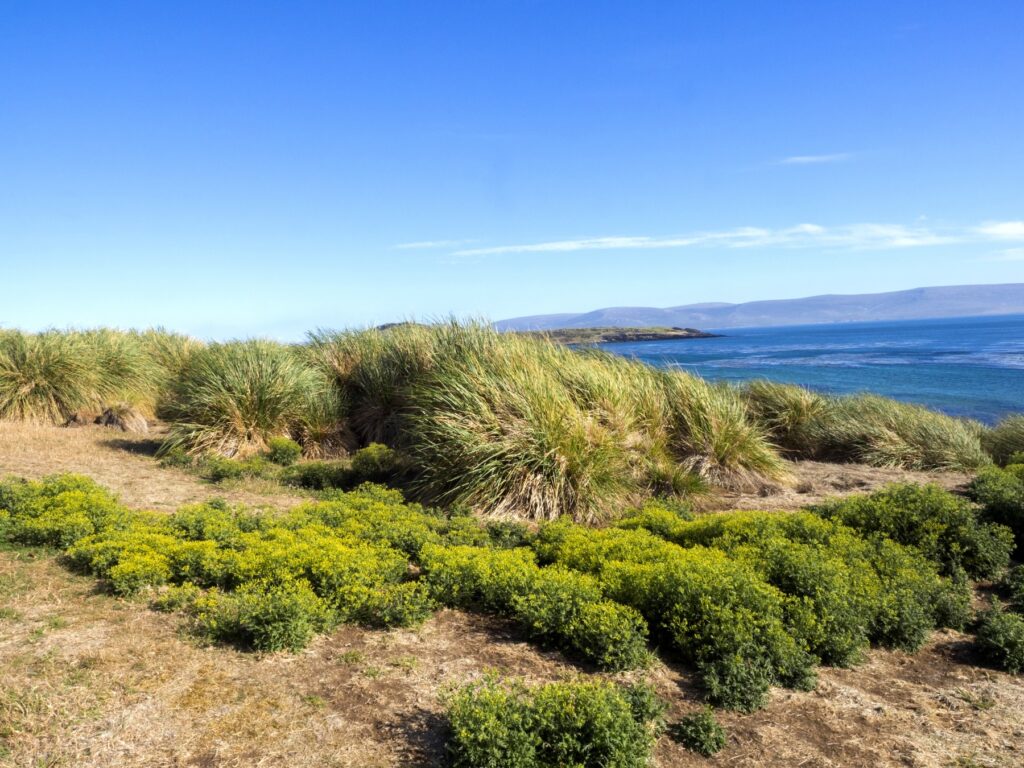
On some of the headlands facing west into Adventure Sound, southern giant petrels can be found nesting. These birds are very shy and are easily disturbed; in order to avoid causing them to fly, keeping a safe distance of 200m is suggested. They will often look like large rocks sat on the flat ground in the distance so can be easily missed.
New Island
New Island has often been described as one of the most scenic of the Falkland Islands. It is located over 150 miles from Stanley; its nearest neighbour is Beaver Island, three miles to the south. New Island is about eight miles (13km) long and half a mile (800m) at its narrowest point.
The highly indented coastline runs for 52 miles in total. The cliffs on the western side of the island rise to 600ft (183m), whereas the eastern shores gently slope into the sea. This island is best known as the home of one of the world’s most spectacular seabird colonies, which accommodates large numbers of black-browed albatrosses (29,000 pairs) and rockhopper penguins (13,000 pairs). It is a popular destination for the many tourists who come ashore from passing cruise ships, attracted by the birds and and the most photogenic scenery.
Seabird colony
The prime aim of a trip to this island is visiting the most accessible seabird colony. In the settlement – a small collection of modern houses overlooking the picturesque Settlement Harbour – you’ll find the jetty, where those with their own boats land. From here, stroll westwards for 5 minutes, past the house with the blue roof, towards the head of the bay.
In this bay lies the wreck of the Protector III, which was beached here in February 1969, having originally been brought to the islands to be used as a sealer based at Albemarle in West Falkland. It is also here where the majority of visitors to the island, arriving via cruise ship, land. The shed at the head of this beach was built towards the end of the 1800s for dealing with sheep and for storage and now houses a small museum where stamps and gifts are sold. This robust building contains a mixture of artefacts relating to different aspects of island life – from the ships that have been wrecked around the islands to farm life – as well as reflecting on the wildlife that can be found in the area.
The gorse bushes that flank the half-mile-long path from the settlement are a superb sight in springtime and are home to many of the small birds which breed here; dark-faced ground-tyrants and Falkland thrushes are easy to spot. The path then crosses a grassy valley, which has been cropped short by generations of rabbits, before gradually climbing up to the higher, western, side of the island. Once past the stile, the tussac grass increases in density as it reaches the cliff edge. The sounds of the colony greet the visitor before the colony itself is visible on the rocky coast. The cliff is not very high at this point but is chock full of birds. This colony is a real mixture, with black-browed albatrosses, king shags and rockhopper penguins all jumbled together. The albatrosses and shags tend to be right at the top of the cliff. Even though some penguins do nest with these other species, they also have their own colonies slightly further inland, in the heart of the tussac grass.
By following the path that leads to the south side of this area, it is possible to get to a good observation point without disturbing the birds. This spectacular site has so much going on it is difficult to know where to look and it is definitely one of the most photographed areas on the islands. Birds are coming and going all the time: the albatrosses glide by with a serene grace and the shags hustle and bustle as they crash land next to the nest, while the penguins porpoise their way through the sea to the base of the cliff before living up to their rockhopper name as they clamber up the cliff to their rookery. Above all this, scavengers keep an eye out for an opening: turkey vultures and Antarctic skuas are the most noticeable, while dolphin gulls the most vocal. Striated caracaras create the most havoc as they glide over the colony, as they are the main predator here. Only the albatrosses seem unperturbed by this ace scavenger.
Fur seal colony
Another recommended site, although rarely visited due to restrictions on time, is the fur seal colony that lies to the north of the settlement. A vague track leads from the valley behind the seabird colonies and heads north, upwards past Rookery Hill. After the best part of an hour, you will reach Landsend Bluff.
Approximately 500 fur seals come back to breed each year on the flat rocky ledges that are found here. The seals can be viewed in safety from the tussac grass at the top of the cliff. There is always something going on in this colony, whether it is the males defending their territory, the females tending their pups or the non-breeding animals playing in the beds of kelp a few yards offshore. Elephant seals do not breed here, but occasionally one or two can be found hauled up on the beach when they have to come ashore to moult. Southern sea lions can also be seen almost anywhere on the island, but usually in small numbers.
Other wildlife
The sheltered eastern side of the island is more to the liking of magellanic penguins and gentoo penguins as it is more low lying than the cliffs of the western side and thus easier for these birds to access. The former make their nests in loose colonies along the shore, avoiding the wetter areas. The gentoo penguins on New Island have large colonies at the north and south end of the eastern side of the island. These are not generally visited, but can easily be seen from a boat. The occasional king penguin will join with the gentoo colonies when they come ashore to moult.
The largest pool on the island is beyond Coffin Bay at the southwestern end. This is the best place to look for any wildfowl on the island, such as speckled teal, Chiloé wigeon and crested duck. There is also a sizeable gentoo penguin colony on the side of the small hill behind this shallow pool. As on the other islands to the west of Falkland, there is always the chance of vagrant birds reaching these shores; the common diuca finch was present in 2017.
One of the most numerous birds on the island is the thin-billed prion. Approaching the island by boat affords views of these grey-and-white seabirds flitting low over the waves close to the shore. This bird spends most of its time at sea, only coming ashore after dark to elude its predators. Some do not escape, and their corpses can occasionally be found near the narrow burrows in which they have laid their eggs. The peregrine falcons that live on this island appear to have learnt how to catch these elusive birds and can be seen flying over the island from land and sea.
Port Howard
The settlement, home to 30 people, is situated at the base of 2,400ft (660m) Mount Maria at the head of its own sheltered harbour. Although this is the largest settlement on West Falkland, you can still walk from one end to the other in 20 minutes and it is only a few hundred yards wide at its widest point because it runs alongside the harbour. It is one of the most picturesque settlements on the Falklands, especially when the gorse is in full bloom in springtime.
Port Howard is one of the few remaining large farming settlements in the islands. The farm is some 200,000 acres and supports 40,000 pure-bred Corriedale sheep. Outside of the shearing season of December, January and February, life can be very peaceful here but, when shearing is in full flow, Port Howard is a hub of activity, with the shearing shed the centre of operations.
The lodge
Staying at Port Howard gives you the opportunity to explore the area around the lodge. A gentle stroll along the main tracks takes in the sites and the settlement’s birdlife, but with a little more time you can walk further to Bull Cove or southwards along Port Howard Harbour. A 4×4 tour allows you to explore the rest of the island and, while the majority of people will visit the sites on West Falkland on a tour organised through their accommodation, Kelper Tours will organise self-catering accommodation and drive visitors on a guided tour around the various sites. Prices start from £150 per person per day for a full day tour.
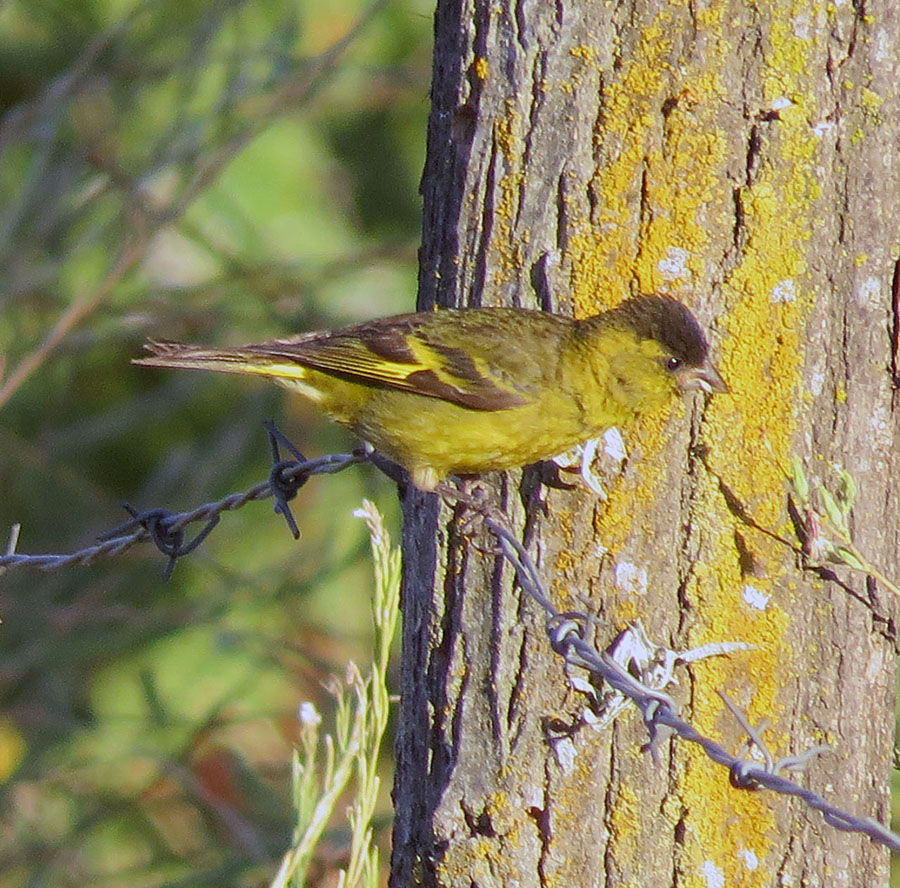
The sheltered gardens of the lodge are a veritable suntrap, and a good place to look for some of the smaller birds – black-chinned siskins often sing from the hedge tops and Falkland thrushes feed on the open grass. On the lawn, beside the lodge is the small museum. Port Howard was occupied by approximately 1,000 troops during the 1982 war with Argentina and much of the equipment left behind after their departure is displayed here. The museum is always open, and the collection gives an idea of what life must have been like during the occupation.
The jetty
From the museum, the jetty is only a 10-minute direct walk through the settlement, along the track that follows the edge of the harbour. However, you can take your time and spend anything up to a couple of hours wandering around, watching wildlife or just admiring the view. The bridge and ford that cross Howard Stream, a few hundred yards along the track, are a good place to look for black-crowned night herons feeding in the stream. Small groups of black-chinned siskins can be seen in the low bushes on the slope above. Where the stream enters the nearby inlet, a flock of speckled teal are usually feeding in the shallows.
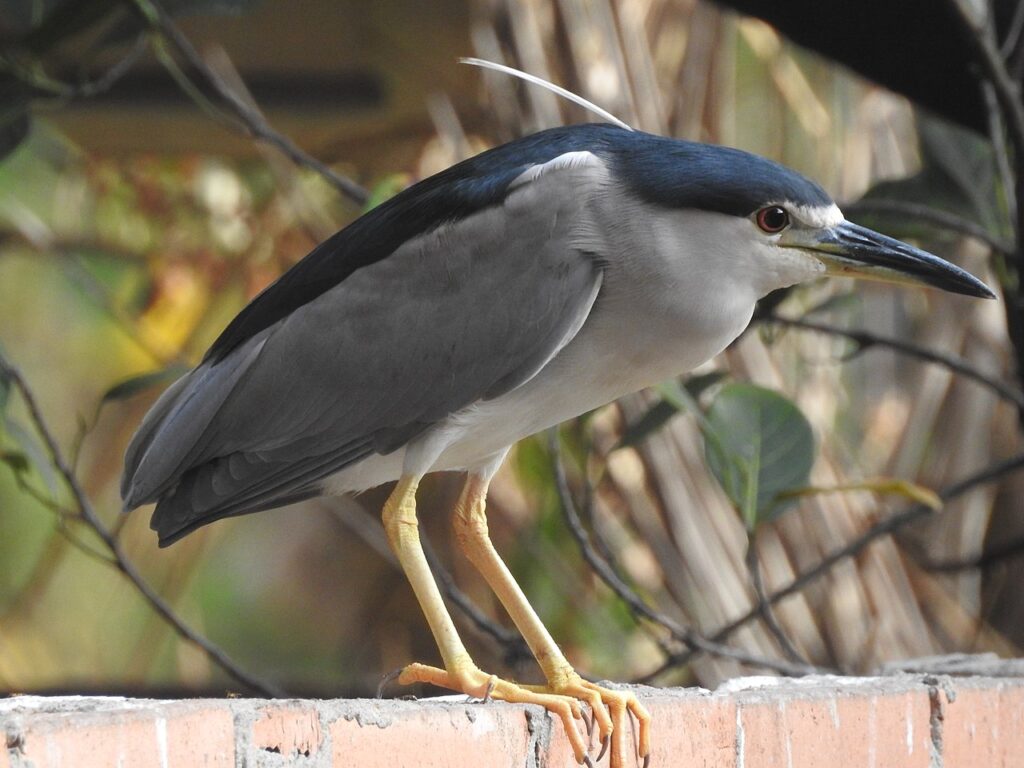
The track winds past the shearing sheds to the quay. The shearing sheds are used several times during the summer, so it is often possible to see how the wool is processed. The track then continues for another 100yds or so before reaching the jetty used by the ferry that links East and West Falkland. From here, it is possible to walk on a short higher track that loops back towards the lodge, passing some of the residential houses, before rejoining the main track before the bridge.
Towards Fox Bay
Another walk takes you northeast from the lodge, along the main road to Fox Bay and the rest of West Falkland. After 100yds, before the newer farm sheds, leave the road and bear right for another 200yds as the track you’re now following rises up towards the airstrip overlooking the settlement. Walk up over the airstrip and along the inlet on the far side of it and, after another 600yds or so, you will reach a small headland and the cemetery where the grave of Captain Hamilton, who lost his life during the Argentinian occupation in 1982, can be found. Bull Stream flows into the far side of this inlet, helping to make a very rich area botanically.
From here, you can retrace your steps or take the track that crosses Bull Stream and return to the main road before heading south back to the lodge, which will take another 15–20 minutes. Alternatively, you can also walk for another 10–15 minutes to overlook Bold Cove and then continue for a similar amount of time up the hill opposite Port Howard – one of the most scenic areas on West Falkland, where there is a cairn to commemorate the 300th anniversary of the first sighting of the Falkland Islands. West from here you can see Port Howard laid out before you and out over the Falkland Sound towards East Falkland on the other side. The highest point on the Falklands, Mount Usborne (705m), is visible on a very clear day.
Beyond the settlement
For those with a 4×4, there are several points of interest that can be reached beyond the settlement. These sites can also be walked, but bank on a full day of walking from the lodge and be sure to carry all supplies you will need with you. The main channel to the south, Port Howard Harbour, is reached by a short, easy walk along grassy tracks by the water or a drive from the settlement. The furthest reaches of the channel are five miles from the lodge. Magellanic oystercatchers and blackish oystercatchers feed along the shore, along with a scattering of two-banded plovers.
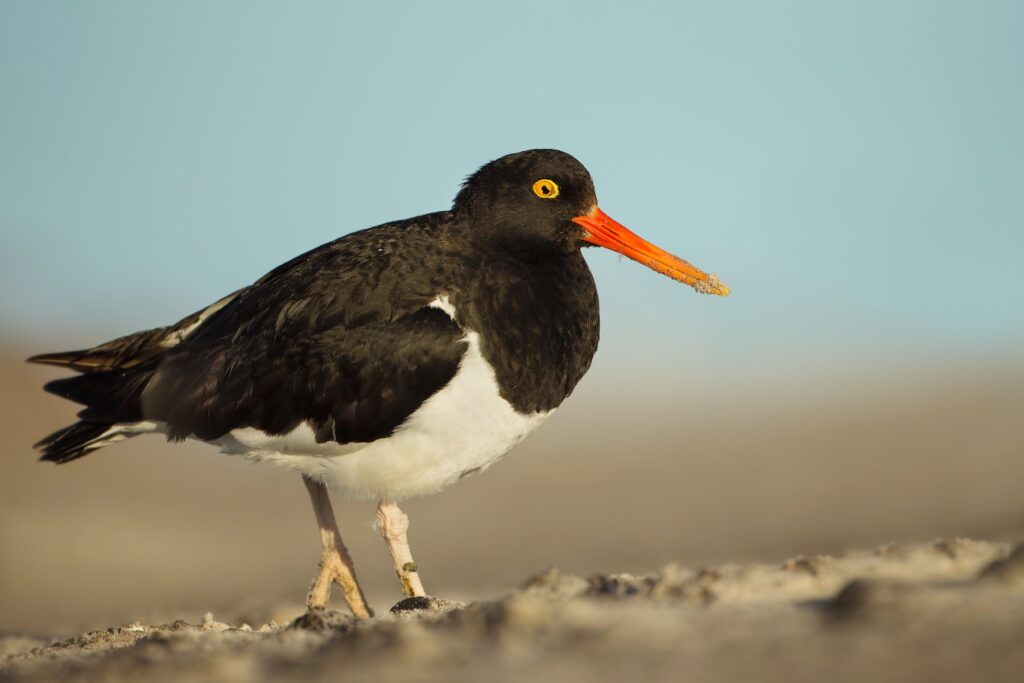
Double River, just over halfway to the far end of Port Howard Harbour, enters the sound in a broad expanse of stone and mud. The views from here are fantastic, looking out from Port Howard Harbour into Falkland Sound. On the return trip, a detour up to Freezer Rocks on the side of Mount Maria is well worthwhile. This line of rocks jutting up through the diddle-dee and ferny vegetation is in a commanding position above the settlement. The views from here are superb – on a clear day you can see over the ridge that is the eastern boundary of Port Howard Harbour, out into Falkland Sound and beyond to East Falkland.
Saunders Island
This island, lying three miles off the northwest coast of West Falkland, comprises 30,000 acres with just over 66 miles of coastline and is operated as one farm. It is historically important in the islands as it was the site of the first British settlement in 1765. The present-day settlement is situated at the base of a range of hills, the highest of which is Rookery Mountain (1,384ft, 422m).
The high cliffs to the north of this range are home to many breeding seabirds, in particular black-browed albatrosses, and rockhopper penguins. These hills are separated from the highest peak on the island, Mount Harston (1,421ft, 436m) by a sandy isthmus known as The Neck. The southwestern part of the island reaches 1,220ft (372m) at the summit of Mount Rees. The lower land between the settlement and Mount Rees has some pools and is the site of the island’s airstrip. The island has become well known as being home to one of the most accessible black-browed albatross colonies on Falkland situated along the northern coasts.
What to see and do on Saunders Island
There is superb walking in the vicinity of both cottages in the settlement. It is possible to book 4×4 excursions from the settlement; both The Neck and the Rookery – the two main sites on the island – are easily reached on day trips from here. Tours out to The Neck are only run for those spending a minimum of two nights in the settlement. At busy times of year on the farm, during shearing periods, for instance, these trips may be curtailed by an hour or so, depending upon other demands on the island owners’ time.
Around the settlement
The settlement contains the main house, the self-catering accommodation, and a mixture of large and small sheds, including the shearing shed that is a hive of activity when the shearing gang are visiting. On an evening walk down to the jetty, visitors will sometimes spot a roosting group of rock shags, and a lucky few have seen a whale or two in the distance in late summer.
A short walk leads you out to the airstrip and then to some pools that have sheltered both silver grebes and white-tufted grebes, a variety of ducks and the occasional black-necked swan. In 1984 the largest of the pools, Big Pond, which is the closest to the settlement, accommodated the largest flock of cinnamon teal that the islands have ever seen when around 20 birds were present. It was thought that they bred there that year. As with any island that lies on the west of the Falklands, there is always the chance that an unusual bird or two will have made its way from South America.
The wildlife colonies below Rookery Mountain
The main attraction of Saunders Island for wildlife enthusiasts is the large colony of black-browed albatrosses that breed along the cliffs on the north coast below Rookery Mountain. The drive out to the colony as part of a day trip from the settlement takes visitors out through the gathering pens before climbing some rather steep slopes to the northeast, through some of the largest areas of Blechnum magellanicum (tall fern) on Falkland before descending to the coast. Depending upon the state of the tide, the track either follows the coastal route or crosses a stream and continues along the beach for a few hundred yards. On the rather low-lying land between this beach and the next, visitors start to see penguins for the first time. Small numbers of magellanic penguins nest on the more arid slopes while gentoo penguins have a small colony a short distance back from the second beach. They can often be seen gathering on the beach in small parties.
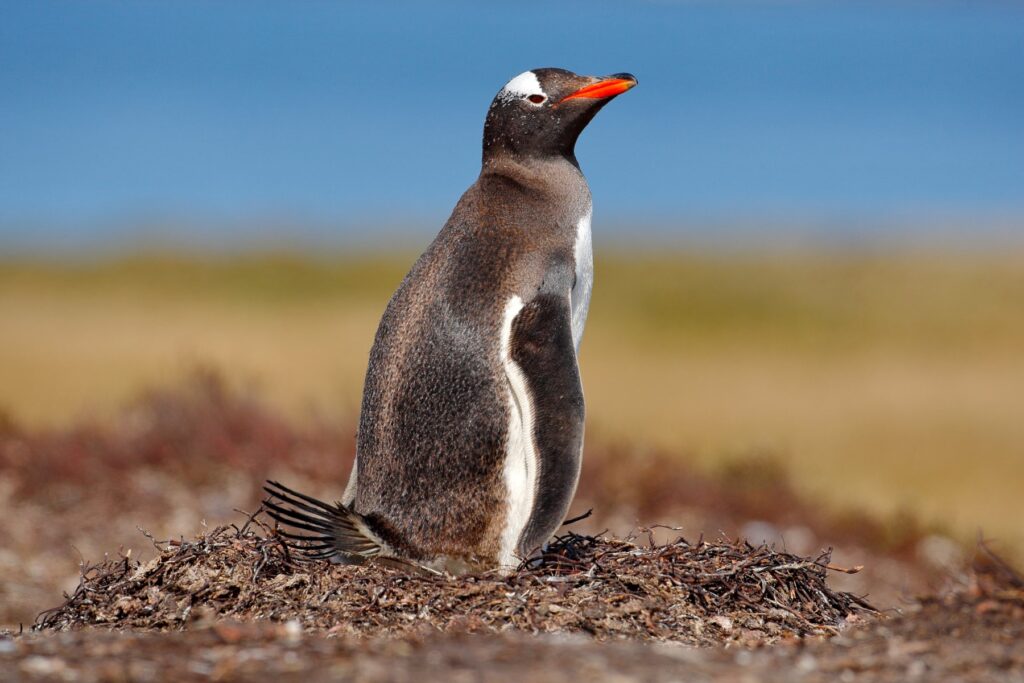
After climbing the steep track at the far side of the second beach, it is approximately a 10–15-minute drive before the black-browed albatross colony is reached. Visitors are usually allowed to remain for at least a couple of hours at this spectacular site. The time spent here will be dictated by the weather and if the owners who are driving you out there have other commitments back in the settlement. Upon reaching the site, the owners usually leave visitors to their own devices, though they usually give a quick briefing before allowing you to explore. A diddle-dee heath runs down from the top of Rookery Mountain to the edge of the cliff.
The albatross colony is situated along the coast on the top section of the cliff. The adults are present between September and April, the eggs are laid during October and fledged young leave the nest between mid-March and early April. The ideal conditions for observing the colony are bright sunshine and an onshore wind. There is then ample opportunity to try and take the ultimate flight shot of these elegant birds as they cruise low over the clifftop. It is possible to sit a few yards from the colony with birds passing low overhead. As with all wildlife, it is advisable to keep a good distance away from these birds (Falklands Conservation’s code of conduct states 6m), so that they are not disturbed and therefore allowed to behave naturally.
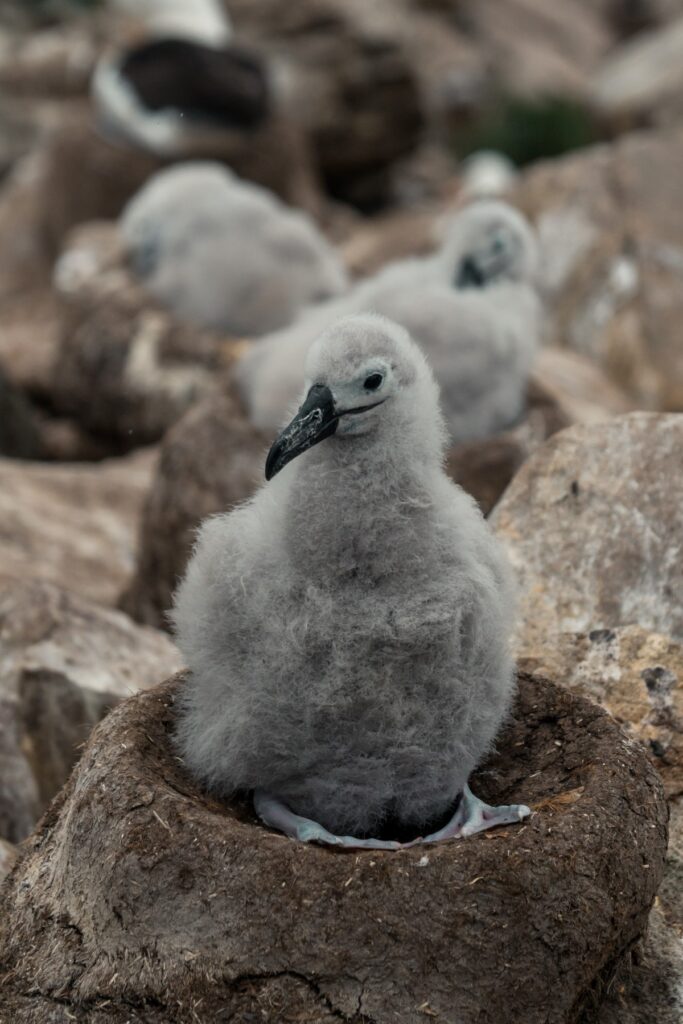
The return trip to the settlement can either follow the same route, if time is limited, or you can follow an alternative coastal track if there is more time. The longer route takes you past the beaches and around a headland to the original location of the Port Egmont settlement. If you park up on the south side of the bay, it is only a short walk of a few yards to see the remains of this historic site. The most visible feature above this shallow valley is the site of the restored graves of the five Royal Marines killed at the end of the 1700s. The largest edifice on the other side of the valley is the remains of a large, stone-built structure lying parallel to the shore. This was once the living quarters and main building for the British forces stationed here in 1766. Visitors can wander around this small site trying to imagine what it would have been like to be stationed here without any modern amenities.
The Neck
The drive out to The Neck, one of the Falklands’ best wildlife sites, takes an hour or so along the track from the settlement that can be rather rough depending upon the recent weather conditions. This isthmus is only a 10-minute walk – from the foothills of Mount Richards to the southeast and Mount Harston to the northwest. It takes about 5 minutes to cross between the beaches on either side of the isthmus meaning the whole area is very accessible.
The low sandy bank between the hills has been scoured by the wind over many years, making this an ideal breeding site for gentoo penguins and magellanic penguins. The gentoo penguins have at least nine satellite sites for this extended colony. Birds seem to be coming and going from both beaches, which can be easily accessed from the gently sloping grassy inclines either side. In the past, a lone chinstrap penguin was occasionally seen mixing with the gentoo penguins. It was a rather shy bird and would soon disappear upon the arrival of humans. Although this was some time ago, chinstrap penguins can occur in any penguin colony at odd times, so keep a lookout. This flat land is also popular with large numbers of roosting gulls, and small flocks of waders have been noted at times.
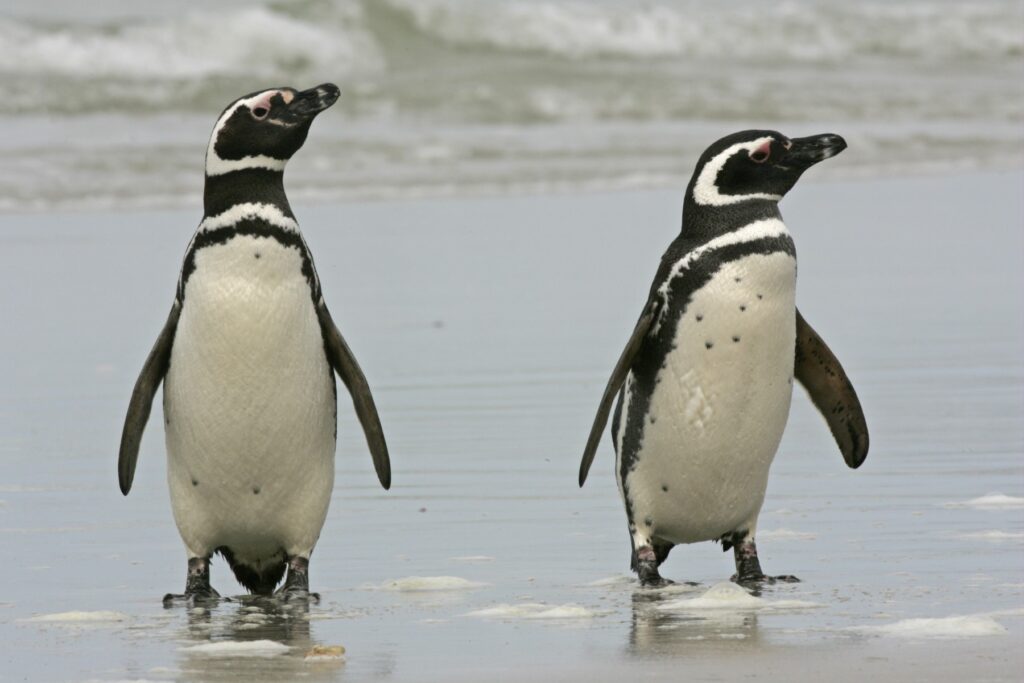
There is no obvious path beyond the king penguins’ territory along the northwest coast. It is worth persevering over some wire fences on the upper slopes. After some 15–20 minutes you will reach a large rockhopper penguin colony on the steeper slopes. As with all grassy cliffs on Falkland, this can be dangerous in wet or windy weather. In the past, this colony has also contained a small number of macaroni penguins – two were present in the austral summer of 2017–18. Large numbers of king shags nest in with the rockhopper penguins so that, apart from the coming and goings of the penguins along their track to the water, there is a constant aerial passage of shags dropping in and taking off from the colony.
Only a short distance away, continuing east along the coast, is the start of the elongated colony of black-browed albatrosses, which extends all the way to the foot of Rookery Mountain. The majority of these birds tend not to fly over The Neck itself but keep out over the open sea. Consequently, although it is still easy to watch the birds on the nest, there are not so many birds to be observed flying by at close range. When up on the higher slopes, either here at The Neck or indeed at the Rookery, on calm days in late summer it is worth keeping an eye out for various large whales, the most likely being sei whale, which can sometimes be seen feeding in the bay.
Sea Lion Island
Sea Lion Island, one of the smallest islands in the Falklands, is one of the most popular destinations for visitors. Lying ten miles (17km) from East Falkland, this island forms a plateau rising to approximately 100ft. It is five miles long and just over one mile at its widest point. From Bull Hill, at the western end, the island slopes gently down eastwards to the open sandy beaches. There are a number of pools on the island. The tussac grass extends around some of the coast away from the cliffs, while inland the habitat is short-cropped turf.
This island has the most accessible breeding colonies of southern sea lions and southern elephant seals. It also has one of the highest densities of breeding birds on the islands. It is one of the best places to see one of the most endangered birds of prey in the world, the striated caracara, locally known as the Johnny Rook.
The sheer abundance of wildlife in such a small area makes Sea Lion Island a must on even the shortest of trips to the Falklands, but especially for those interested in photography: many of the published photographs of Falklands’ wildlife have been taken on Sea Lion Island.
Wildlife
In sheltered spots there is the chance of meeting sleeping sea lions or elephant seals. Upon arrival, visitors are given a rough map of the island from the lodge, on which one area, East Loafers on the southern coast, is marked as being out of bounds as this is the main breeding area for southern sea lions. These are dangerous animals and are best viewed from the top of the cliff. Southern elephant seals, easily seen around the sandy shores of the eastern end of the island, are a different matter as they are less aggressive. However, you must keep a respectful distance from them – the standard advice is to remain at least one of their body lengths from them, and to make sure that they always have access to the sea, never getting between them and the water.
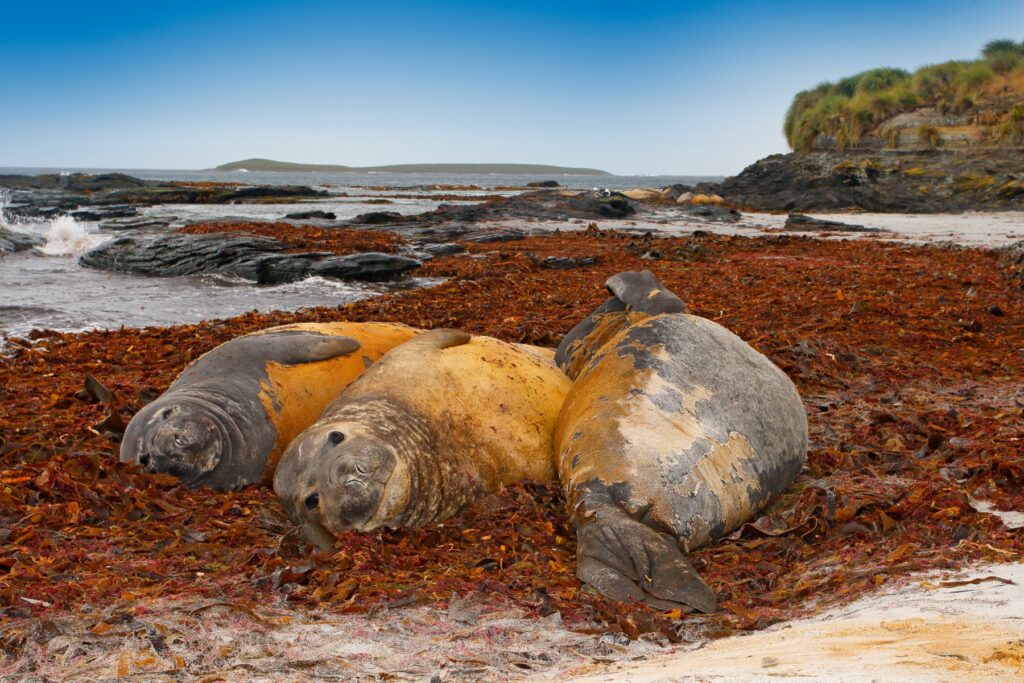
Of the 50-plus species of birds in the Falklands archipelago, two deserve a special mention. The Falkland skua can be very energetic in defence of its territory, by dive-bombing any intruder. Most of the skuas nest in the open grass at the western end of the island, with a few nesting just off the main track from the lodge towards the eastern end of the island. These large birds can be seen on the nest and are best admired from a certain distance. This distance will vary from bird to bird, but when they start to sit up and take notice of you, it is the time to find an alternative route. The other species is the striated caracara – these beautiful, inquisitive birds of prey have a strong liking for shiny or brightly coloured objects so when they’re in the area, it is a good idea to keep a close eye on your possessions.
Walks
Walking around Sea Lion Island on the open, grassy turf is fairly undemanding but, as everywhere, there are some essential ground rules. At the lodge, and on the introductory tour, advice is given regarding the ground rules for the welfare of the wildlife. This enables the visitor to approach both animals and birds safely, without causing the wildlife any distress.
Cow Point, North East Point and Elephant Corner
It is possible to explore the eastern end of the island before lunch. The closest beach, Cow Bay, can be reached by cutting across the field to the north of the lodge and continuing down a shallow valley through the tussac grass towards the sand. Many magellanic penguins nest in this area, including one pair often seen using a burrow almost under one of the old stiles. A walk westwards along the beach should find upland geese and kelp geese, as well as several noisy groups of magellanic oystercatchers.
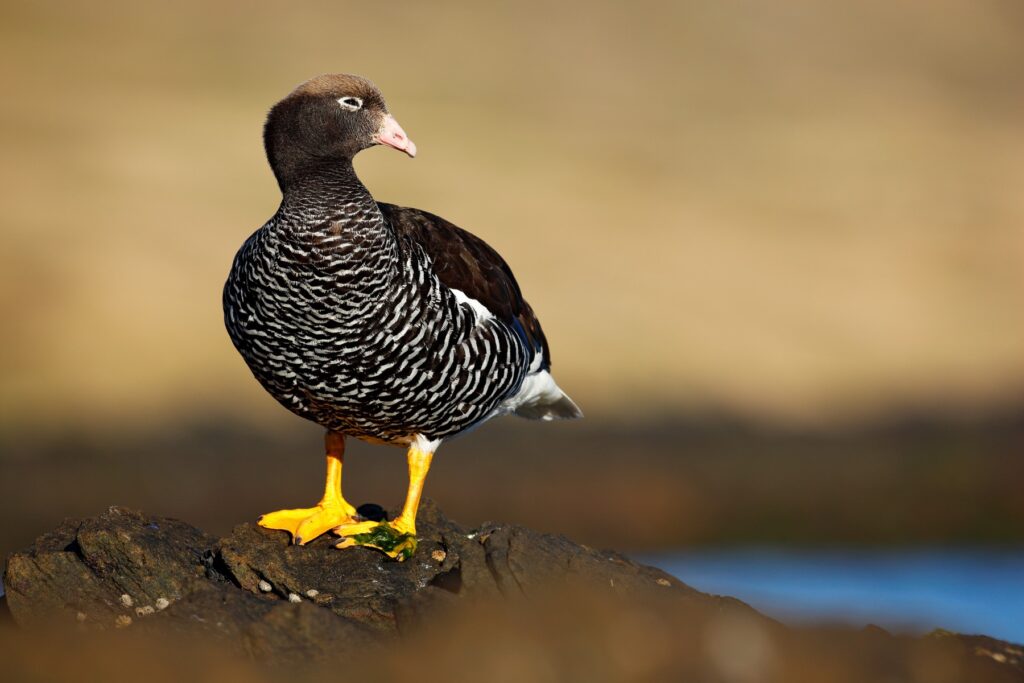
Turning around and heading east, one can walk along the sand towards Cow Point. The sand does disappear in places and it becomes necessary to walk over flat rocks. Two stretches of large boulders, around 100yds along the beach, can be difficult to navigate so take care. This area has many small birds, including Cobb’s wrens, popping in and out of the stones at your feet, while elegant dark-faced ground-tyrant catch flies at the top of the beach. From Cow Point, small numbers of gentoo penguins can be seen porpoising their way back to the shore through the banks of offshore kelp. These penguins are making their way to the long sandy beach that stretches eastwards from here. The large gentoo colony is a dominating presence at the top of the beach and is clearly designated, a wire fence ensuring that the penguins are not disturbed. It is always worthwhile looking at this colony to see if there are any king penguins present.
Behind the sand beach, shallow temporary pools which form when high tides coincide with windy days to push water into this area, can sometimes be seen. When the pools are present, many small wading birds can be found feeding in them. Along with the two-banded plovers, there are often many white-rumped sandpipers that have come here from their North American breeding grounds. Continuing east for less than 10 minutes to the far end of the beach, there is a small colony of southern giant petrels.
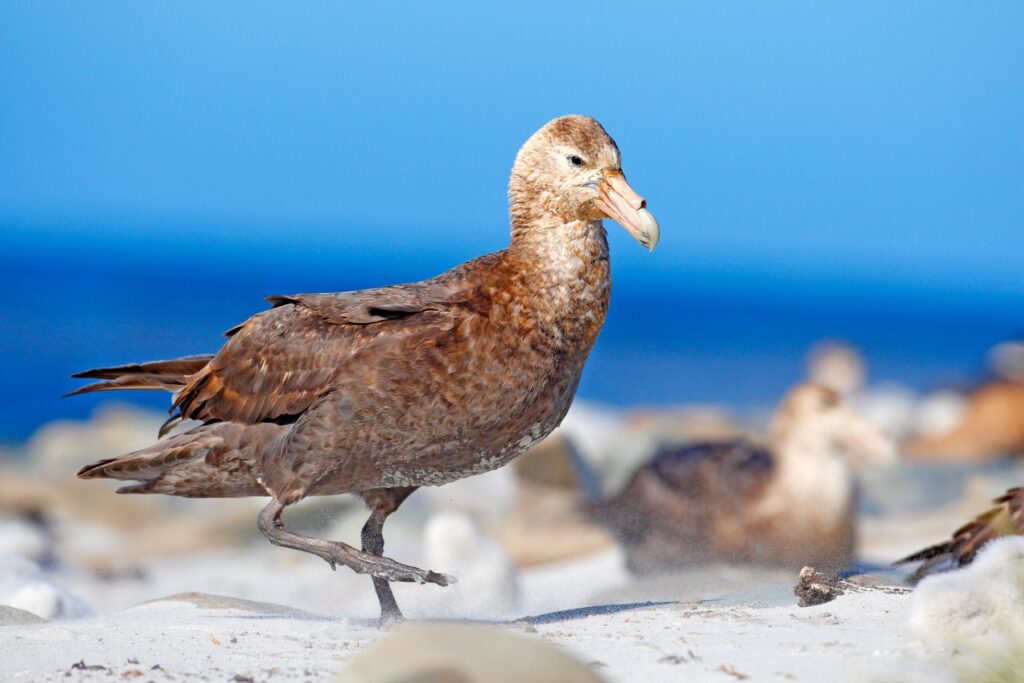
A few minutes’ walk south from the giant petrel colony takes you to a beach that both magellanic oystercatchers and blackish oystercatchers can be found nesting at the top of. As their nests are well camouflaged, walkers must watch out for displaying adults and thus avoid the nesting sites. The beach is also another favourite haul-out site for elephant seals, with one favoured site at the eastern end of this beach, and even more found at the western end, a 20-minute stroll away.
Just beyond the big haul-out site, you can walk around 100yds on to some grassy slopes (a super place to watch both upland geese and ruddy-headed geese), behind which there is a small bay, the aptly named Elephant Corner. Here, visitors can push through the tussac grass on the path of least resistance in order to reach a low promontory in the middle of the cove. The elephant seals can be viewed in safety from here and it is an excellent spot for photography.
Stanley
Stanley is probably the smallest and most remote capital city in the world. The official existence of Port Stanley began in July 1845, when the islands’ capital was moved from Port Louis to an area originally called Jackson’s Harbour. It was situated on a north-facing slope in order to face the sun throughout the year. It grew dramatically during the Californian Gold Rush in the mid 1800s with this boom lasting until the 1890s. Subsequently, Stanley has continued to be the commercial centre of the islands and the main port of access.
A wide range of architectural styles prevails in the city, ranging from the magnificent brick-built Christ Church Cathedral, to Jubilee Villas – an imposing terrace of four tall, red-brick houses with large bay windows, to the hospital and school with their colourful roofs and white-clad exterior. Upland geese and Falkland steamer ducks frequent the waterfront, while turkey vultures and kelp gulls glide overhead. It is also one of the few places on the islands where house sparrows, introduced during the 19th century, have remained plentiful. Stanley is where many Falkland holidays start and finish, and therefore it has a good selection of accommodation and tour operators able to cater to visitors’ tastes and interests.
The Historic Dockyard Museum and around
A good place to start is at the new Historic Dockyard Museum situated in the old dockyard on Ross Road. The perfect starting point for a history lesson about Stanley, the museum houses information ranging from the first settlers up to the present day. Exhibits cover every aspect of life in the Falklands including the Falklands War and other conflicts, camp life, shipwrecks and natural history. There is a very poignant video playing in one room, showcasing interviews with islanders about their experiences during the war. To see it all takes the best part of 2 hours, with some visitors coming back for more than one visit.
The main museum building is situated in an old store, one of the oldest buildings in Stanley, which dates back to 1843. The site beyond once included storerooms, workshops, a jail, a magazine (used for storing munitions) and a smithy, and many of these buildings have been restored to their former glory as part of the museum’s exhibits. For those seeking refreshment, the Teaberry Café is on site.
Liberation Monument
The memorial just opposite the Historic Dockyard Museum is the Liberation Monument. Paid for by public subscription and erected by volunteers, the monument was officially unveiled on 14 June 1984. The military personnel who gave their lives to liberate the islands are remembered on the surrounding wall. Liberation Day, 14 June, is marked in the islands each year by a public holiday.
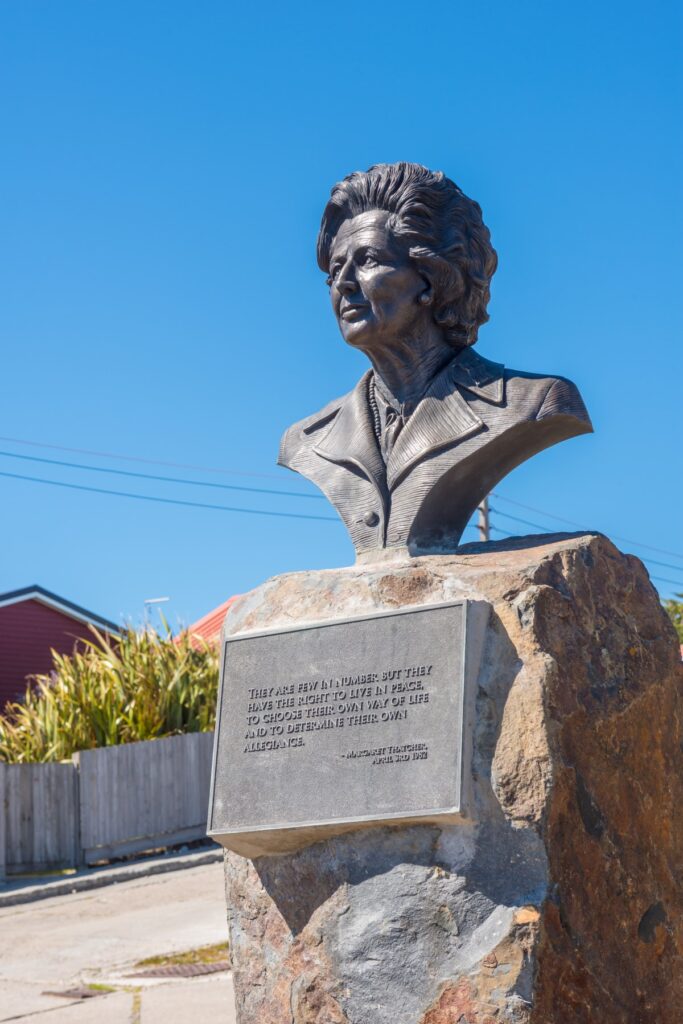
Some 50yds away is the bust of Margaret Thatcher, prime minister at the time of the Argentine invasion, and largely held responsible for the decision to send the task force to regain control of the islands. The Secretariat, just behind these memorials, houses the islands’ administrative offices and treasury buildings. Adjacent to these buildings is Cable Cottage, the Attorney General’s Chambers, which housed the Stanley end of the telegraph cable that linked the islands to Montevideo in the early 1900s.
Government House
Just below the community school playing field is a long-angled driveway that leads up to Government House. Originally built in 1845, this building has been regularly extended, improved or just generally altered over the years. Every governor and his wife seem to have added their own touch to the building. Each spring, when the gorse hedges are in bloom, this is a very picturesque situation in the lee of the macrocarpa trees. The conservatory at the front of the house is home to one of the most prolific grapevines on the islands.
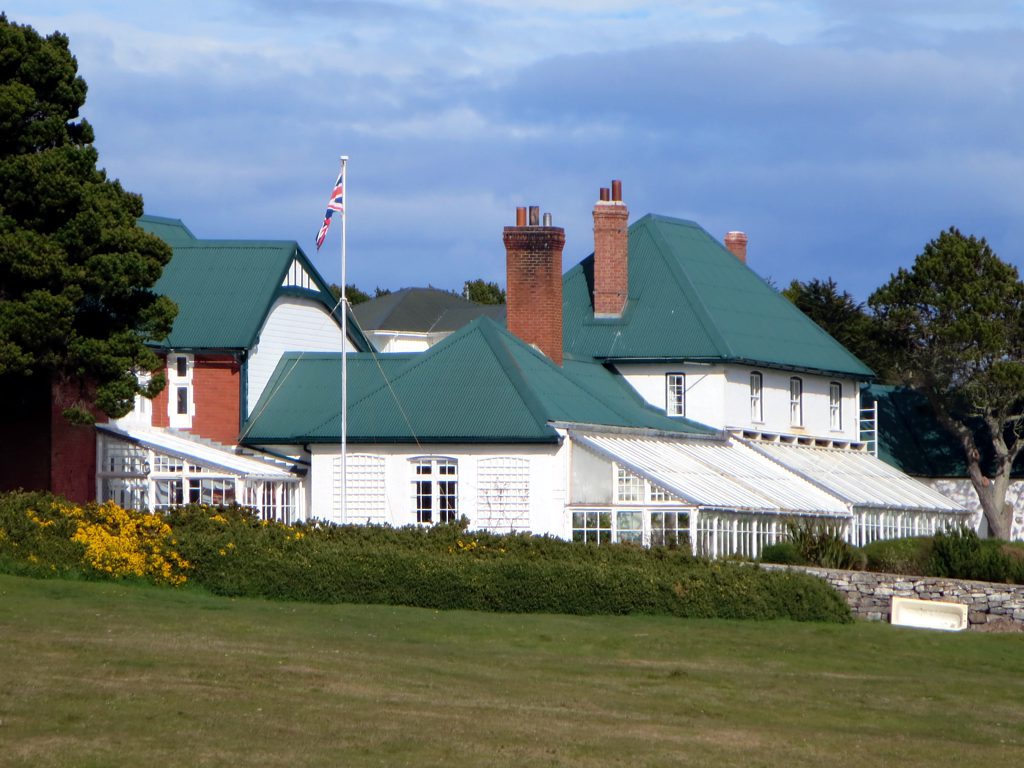
The house itself, though not open to visitors, is full of all manner of memorabilia from throughout the ages. Outside the west entrance are a pair of brass guns cast in 1807, and elsewhere there is a harpoon gun that was presented by a South Georgia Whaling Station and a shell that is supposed to have come from the German cruiser Leipzig. The bullet holes still visible in the walls mark the most dramatic period in the history of this building, which suffered during the invasion and subsequent recapture of Stanley from the Argentinians. The large trees are a good place to look for some of the smaller birds such as black-chinned siskins and the occasional swallow blown in from South America.
1914 Battle Memorial
This monument commemorates the Battle of the Falklands fought on 8 December 1914, in which the British Squadron under the command of Vice Admiral Sturdee destroyed the German Squadron under Vice Admiral Graf Von Spee. A public holiday on the Falklands was declared on this date and every year there is a parade and a ceremony, which includes a display by the Royal Air Force and the Royal Navy. The memorial was paid for by public subscription and was first unveiled on 26 February 1927.
Between SURE’s headquarters and the memorial is a memorial wall built in 2014 to commemorate the centenary of the two battles at sea in World War I. There are three plaques on the wall, detailing information about the two battles and the people involved. There are also a couple of benches and a pretty flower garden – this is a quiet place to sit in the sun out of the wind.
Christ Church Cathedral
Christ Church Cathedral must be one of the best-known, most-photographed buildings on the islands. It is the southernmost cathedral in the world and for part of its history was the main cathedral for the missionary diocese of South America.
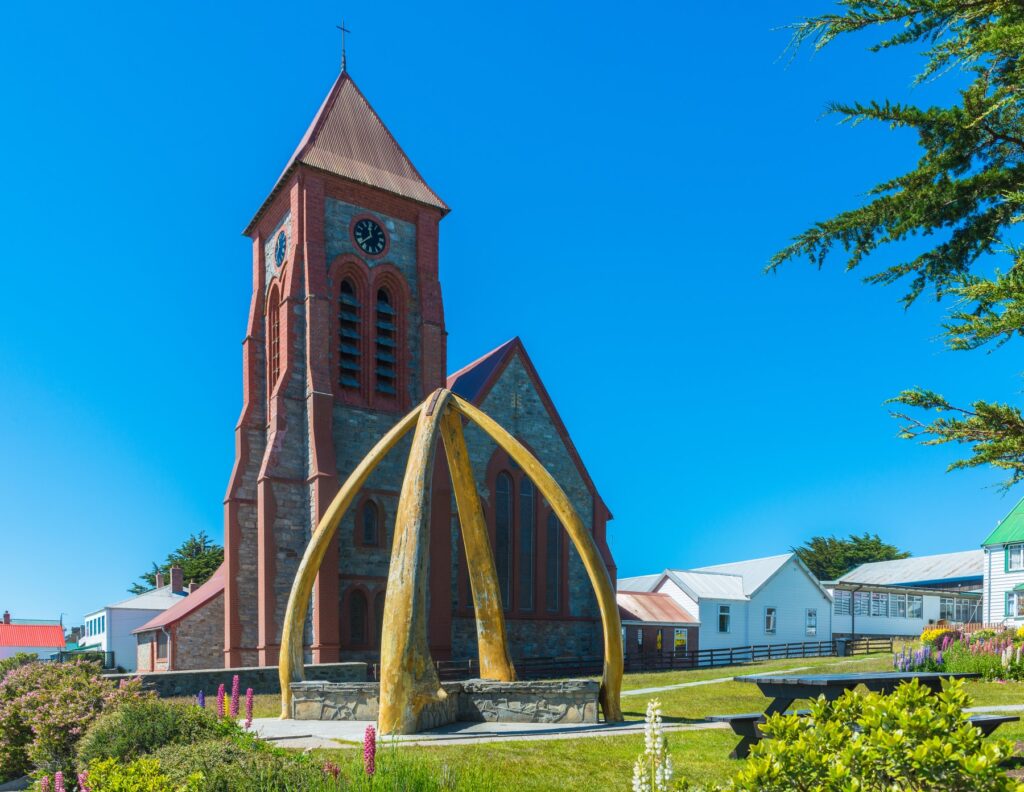
Consecrated in 1892 and finished in 1903, it has remained in use to this day. The whalebone arch, situated next to the cathedral and made from the jawbones of two blue whales, was presented to the islanders in 1933 by whalers from South Georgia. The arch and the cathedral were renovated in 1991.
Jubilee Villas
About 300yds further on, at the head of the public jetty in front of Jubilee Villas, among the oldest buildings in Port Stanley, is a small plaque commemorating the visit of HRH Prince Alfred, Duke of Edinburgh in 1871, the first royal visit, and the visit of the present Duke of Edinburgh in 1957. The easternmost building is now the offices of Falklands Conservation, a non-governmental environmental charity, which is involved with a wide range of research and advisory roles concerning the islands’ wildlife.
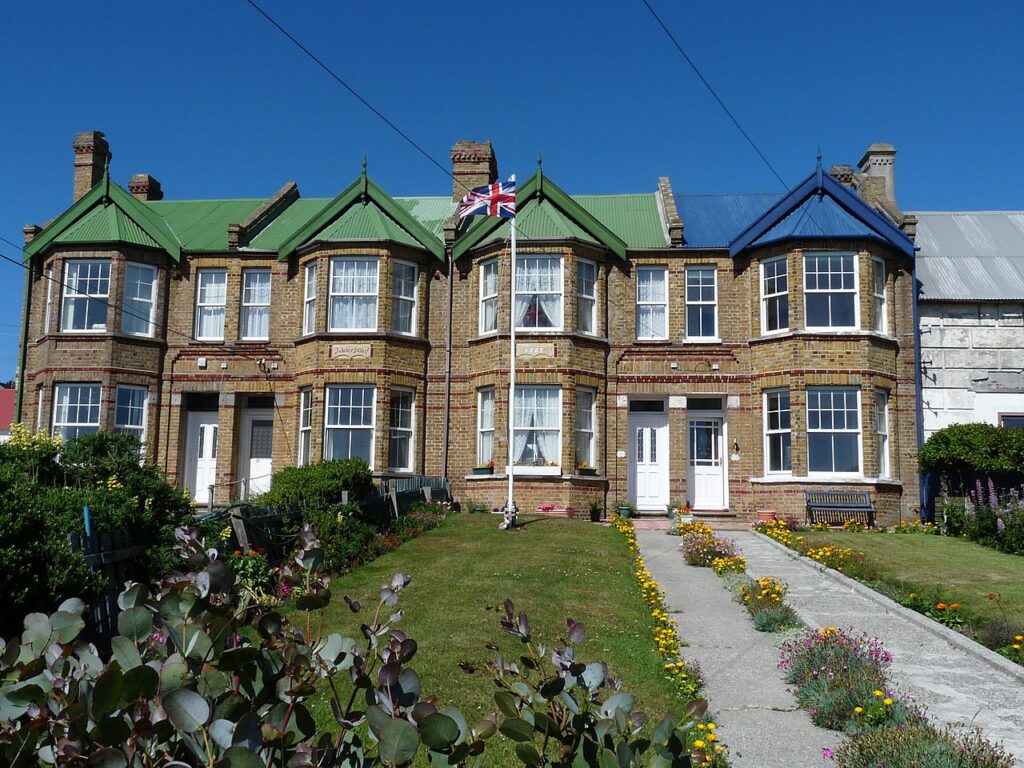
The ruins of the William Shand are best seen from the public jetty looking towards the East jetty. This barque, built in Greenock in 1839, visited Stanley on the outward journey from Liverpool to Valparaíso in February 1859, and returned to the islands after a severe battering as she tried to round Cape Horn two months later. She was condemned and ended her days in Stanley.
Sapper’s Hill
A superb view over Stanley can be had from Sapper’s Hill, which overlooks the town from the west. From here you can see Stanley laid out before you, over the harbour to Port William, and out over the South Atlantic Ocean to the south. This viewpoint is reached by heading west towards Government House from the Historic Dockyard Museum, but turning south down Darwin Road, following it to the Stanley– Mount Pleasant Airport Road for half a mile and then turning on to the track that leads up the hill for a few hundred yards.
On the way back, you can take a different route by following the Stanley Bypass and turning left into Dairy Paddock Road before soon reaching one of the most unusual gardens in Stanley. In the gardens, next to the sign, ‘say no to whaling’, are the impressive skulls of killer and sperm whales along with a metal sculpture of a whale and a harpoon gun from the whaling days. By continuing down Dairy Paddock Road for another 100yds, you come to Pioneer Row, where some of Stanley’s best-preserved older houses can be found.
Volunteer Point
Volunteer Point is named after the Volunteer, a ship that visited the Falkland Islands in 1815. This privately owned nature reserve is on a narrow strip of short grass that connects East Falkland to the headland of Volunteer Point itself and is bordered by the two-mile-long Volunteer Beach to the north and by Volunteer Lagoon to the south. The wardens’ house is at the western end of the grassy area, while the king penguin colony is at the eastern end.
This colony is one of the highlights of any visit to the Falkland Islands – it is the largest colony of this species on the islands and is still increasing. There are two additional species of penguin, and many other birds breed in this fabulous scenery. As you near the site on the tracks from Johnson’s Harbour, the whole area opens up spectacularly before you, revealing the lagoon, penguins and beach.
King penguins
The main penguin colony does move slightly from year to year, but is always located between the valley and the southern boundary fence. These birds are used to the presence of visitors throughout the year but a distance of 7.5m must be respected. It is possible to get close views of the birds by sitting beside their main routes to the sea and waiting for them to come and inspect you. The majority of the inactive birds in the main group are probably incubating their huge, single egg. This egg is sometimes visible on top of the penguin’s feet as it awaits incubation, but is hidden when the bird sits down. The penguin’s stiff tail feathers help prop the bird upright when it is incubating or roosting. Penguins can also rest by lying prone on the ground but seem to prefer to remain upright, presumably as this gives a better chance of spotting any approaching predators.
The air around the rookery is full of soft piping noises through the summer. This sound is the young calling to their parents. When just hatched these youngsters are small enough to stay hidden under the folds of their parents’ skin, especially on cold windy days, but as they get larger, or on warm days, their heads peep out just above the parents’ feet. Chicks, which have grown too big to fit under the parent birds, still try to hide by pushing their heads into their former haven. They look a rather comical sight, only their head hidden, the rest of the body exposed to the elements. As they grow, the chicks grow a very fluffy, brown, downy coat to protect them from the cold.
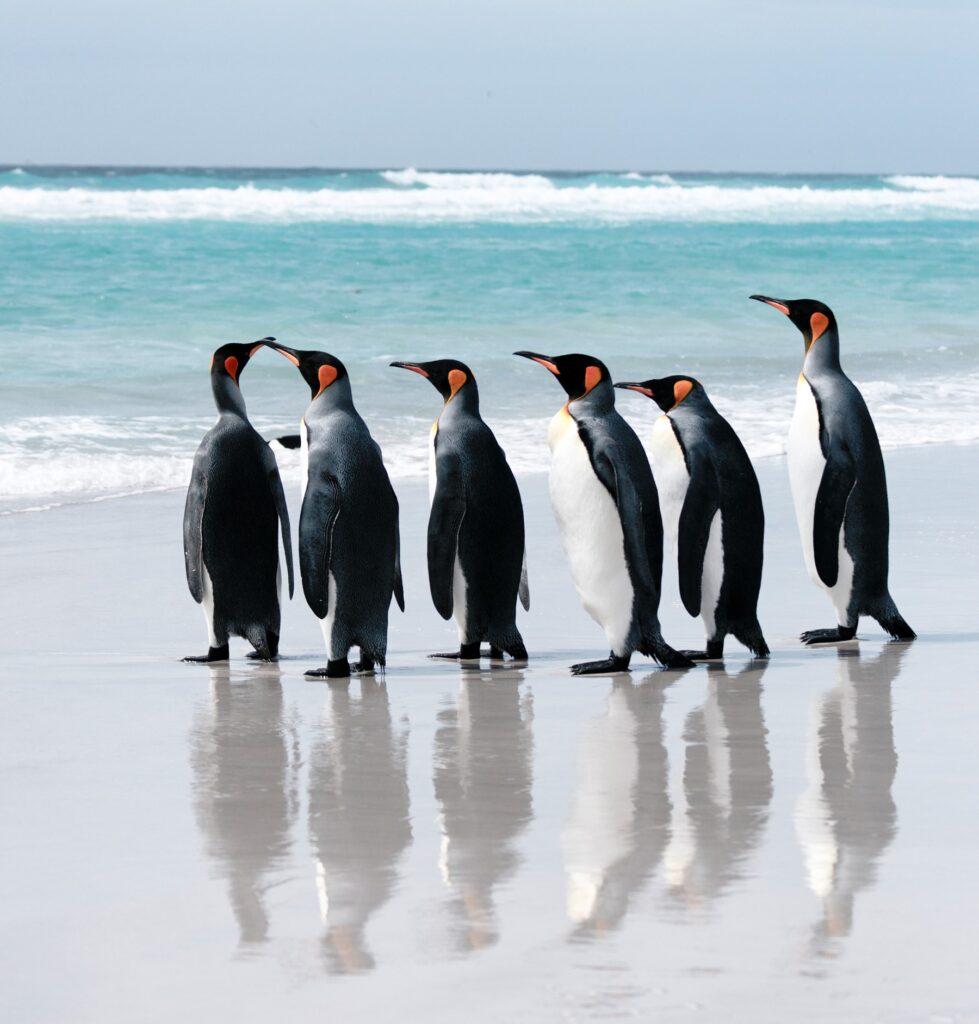
The main breeding activity takes place around the principal flock, but there are usually several smaller groups nearby. There may be some young birds in these satellite groups, but they are usually non-breeding adults. Males seeking a mate wander around the main group, adopting a very exaggerated strutting walk and batting each other with their flippers. Owing to their staggered breeding cycle there will always be some pairs starting earlier than others, but generally birds will be incubating between November and January with small young being visible from early in the new year until late February, after which they will be much easier to see as they are too big to hide under their parents.
The majority of the birds return to the sea at Volunteer Beach. Some walk in the other direction, to the lagoon, where they can be seen washing and splashing about in the shallows. The low banks above the small beach on the edge of the lagoon make a good vantage point for observing these birds. Sometimes they can be seen swimming in the shallow water and the graceful speed of their movements is in stark contrast to their upright waddling gait on land.
Gentoo and magellanic penguins
King penguins constitute the main attraction of Volunteers, as the sanctuary is known on the island, but they are not the only penguins breeding prolifically on this grassy bank. Two colonies of gentoo penguins occupy the lagoon side of the bank a short walk from the king penguins. The number of colonies has varied over the years. Sometimes two groups of gentoo penguins will merge, while in other years they will remain apart, but the overall number of birds does not vary significantly, with around 1,000 pairs using this site in recent years. By late summer all the young will have been gathered into crèches in the middle of the colony for protection from predatory birds. It is quite a sight when the young race after their returning parents to beg for food. The adult’s purpose is twofold: it wants to teach its offspring to feed and also wants to ensure that it is nurturing its own young and not its neighbours’.
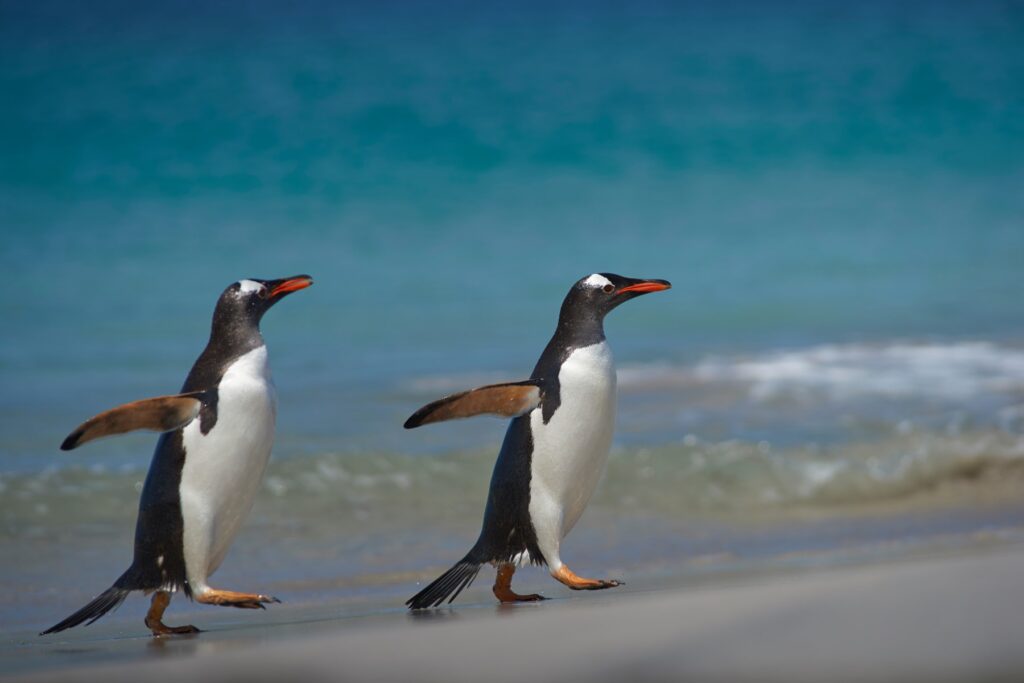
Magellanic penguins prefer the beach side of the bank where the drier, sandy ground is much more suitable for digging burrows than the wet, peaty ground. The bank above the beach is, therefore, riddled with both used and unused penguin burrows.
Other flora and fauna
After the penguin colonies have been visited there is plenty more to see. The flora is dominated by grasses thanks to the grazing birds and sheep. Some of the wetter valleys are full of gunnera, with its inedible red berries hidden under the leaves in late summer. The most colourful flower is the sea cabbage with its silvery white leaves, fluffy to the touch and topped by bright yellow flowers at the height of the summer. The seeds formed during January are a preferred food of the islands’ smallest finches, the black-chinned siskins. The sea cabbage grows above the shoreline, anchoring the shifting sands.
In the lee of the sea cabbage, small groups of waders gather in late summer, the majority of which are white-rumped sandpipers that have come from North America to winter on the islands. The other birds are the resident two-banded plovers, which breed above the high-tide mark, so it is sometimes possible to find some of the young racing from one clump of sea cabbage to the next.
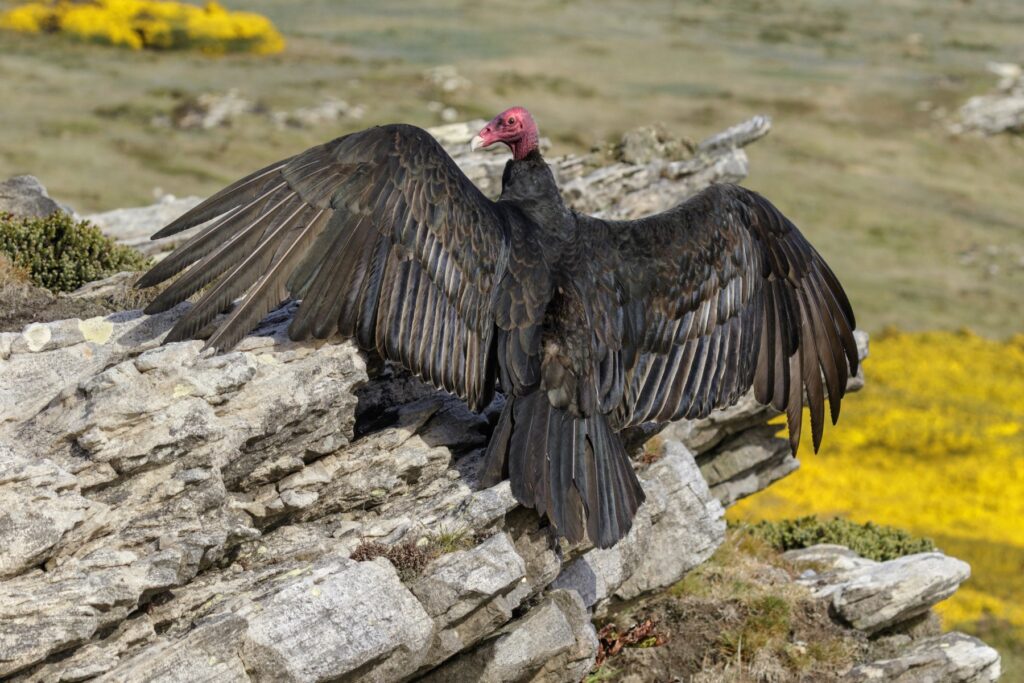
The second most frequent species, after penguins, are geese. Upland geese and ruddy-headed geese frequent all grassy areas. By late summer they have gathered into large family groups. Habitually the males gather together flocks of juveniles, irrespective of their parentage or age. According to one theory, this behaviour suggests that the males use unrelated offspring as an avian shield for their own goslings, the probability being that any predator will not detect their young. The predators here are mostly avian; turkey vultures and variable hawks are the most numerous and can be seen around most penguin colonies, while peregrine falcons circle high over Volunteer Point.
The small islets beyond Volunteer Point, although out of sight at the far end of the reserve, are the haunts of fur seals; visitors are not allowed to access these areas, but the seals can sometimes be seen zooming through the surf on to the beach. Elephant seals have been recorded on some of the sand beaches but, like fur seals, they often pick sites that are not readily accessible to tourists.
West Point Island
West Point Island, owned by Roddy and Lily Napier and run as a farm, is not one of the bigger Falklands islands. Covering 3,630 acres, it is five miles long and just under two miles at its widest point. The population is just two, plus Bosun the dog. Despite its size, there is more than enough for walkers and naturalists to see here – whether in a few hours on a stop from a visiting cruise ship, or for a full day when visiting from nearby Carcass Island.
The island is renowned for its huge colonies of black-browed albatrosses on its western side, on some of the most spectacular cliffs in the archipelago. The area around the small settlement, where the island’s buildings are, is at its most colourful in springtime when the densely flowered gorse is in bloom. Sheep are still kept here, but tourism is the source of most of its income. The highest point on the island is Cliff Mountain at 1,250ft, while nearby Mount Misery stands at 1,211ft above the albatross cliffs. The channel, located at the narrowest point between West Falkland and West Point, is Woolly Gut, which is strongly tidal before it opens out into West Point Pass to the southwest.
What to see and do on West Point Island
Afternoon tea
As on the neighbouring island of Carcass, the welcome and afternoon tea provided at the farmhouse for cruise-ship passengers are some of the highlights of a visit to West Point. Even though the main aim of landing on the island is to visit the seabird colonies, the concept of tea and cakes should be high on your agenda, along with taking a look around the settlement.
Birdlife
The birdlife of West Point, although not as varied as that on Carcass Island owing to the introduction of cats, rats and mice years ago is still present, only less abundant. It is now believed that cats have been successfully eradicated and there has been some recent work to remove the rat population around the settlement resulting in an immediate increase in the number and diversity of smaller birds. Some, such as black-chinned siskin, Falkland thrush and grass wren survived the higher rat numbers quite well by breeding on cliffs inaccessible to rats. These birds can be heard singing on spring mornings with others now being noted on a more regular basis.
Tussacbirds are now also being seen regularly and there have been recent reports of possible sightings of Cobb’s wren which is very good news. The lush garden and vegetable patch, close to the farmhouse, are good places to see some of these species. Male long-tailed meadowlark, known locally as military starling, look particularly fine when perched on flowering gorse bushes. Their red breasts stand out from a long way off.
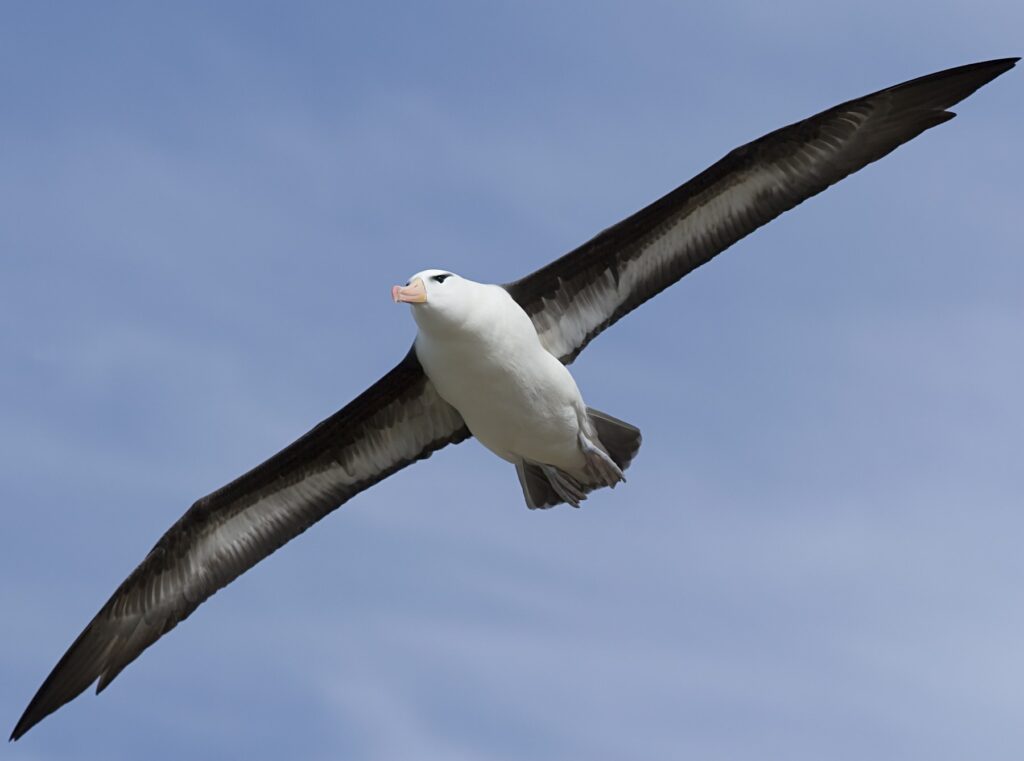
The major attraction is the impressive black-browed albatross colony located on the western side of the island. From the settlement, it is about a 5-minute drive to the colony – the managers will be able to give you a lift. Alternatively, the colony is an easy 30–40-minute walk along a grassy track that is marked by red-topped stakes and passes through a series of fields before reaching the inner edge of the tussac grass that grows on the island’s periphery, at a safe distance from the local sheep.
The birds situate their mud-pot nests on the top of the slope, so that they can land and take off without too much difficulty. With a wingspan of over 7ft (2.13m), they need plenty of room to get to and from their nest site in safety. The main path leads down to the colonies for a few yards before splitting. You can then follow either path to loop around the colony, walking from one end of it to the other. It is therefore possible to take a circular walk and get wonderful views only a few feet away from the birds. As long as you stay on the path in the tussac the birds carry on with their daily activities without seeming to be concerned by your presence. In the past, some of the albatrosses in this colony were ringed as part of a research project to determine the longevity of the species, where the albatrosses went after leaving the island and if they returned here to breed.
Dolphins
The waters around the island are favoured haunts of Commerson’s dolphin. They follow many of the boats into the harbour, often playing in the bow wave as the ship enters the harbour.
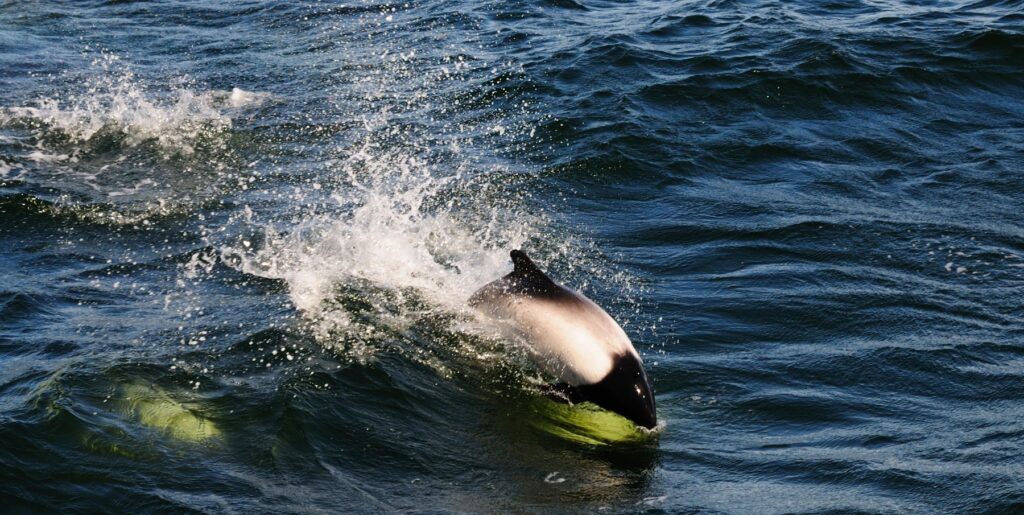
From the westward side of the island it is possible to see the occasional fur seal swimming close inshore, and on very calm days some of the great whales, most commonly sei and southern right whales, have been seen from many locations around this island.
Related books
For more information, see our guide to the Falkland Islands:
Related articles
The Falklands offer perfect opportunities for professional and
amateur photographers alike.
Breathe in the glorious unpolluted air.
Spend a day in the one of the most remote capital cities in the world.
Including wildlife-watching, fishing and hiking – there’s something for everyone!
The 40th anniversary of Liberation Day sees a packed programme of events in the Falklands.
